This is a list of dinosaurs whose remains have been recovered from Asia, excluding India, which was part of a separate landmass for much of the Mesozoic (See List of Indian and Madagascan Dinosaurs for a list of Dinosaurs from India). This list does not include dinosaurs that live or lived after the Mesozoic era such as birds.
Criteria for inclusion
- The genus must appear on the List of dinosaur genera.
- At least one named species of the creature must have been found in Asia.
- This list is a complement to Category:Mesozoic dinosaurs of Asia.
List of Asian dinosaurs
Valid genera
| Name | Year | Formation | Location | Notes | Images |
|---|---|---|---|---|---|
| Abdarainurus | 2020 | Alagteeg Formation (Late Cretaceous, Santonian to Campanian) | Inconsistent in phylogenetic placement; could represent an unknown lineage of macronarians[1] |  | |
| Abrosaurus | 1989 | Shaximiao Formation (Middle Jurassic, Bathonian to Callovian) | Had unusually large fenestrae |  | |
| Achillobator | 1999 | Bayan Shireh Formation (Late Cretaceous, Cenomanian to Santonian) | Its robust build suggests it was not a cursorial animal[2] | 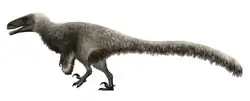 | |
| Adasaurus | 1983 | Nemegt Formation (Late Cretaceous, Maastrichtian) | Its sickle claw was markedly reduced compared to other dromaeosaurids |  | |
| Aepyornithomimus | 2017 | Djadochta Formation (Late Cretaceous, Campanian) | The first ornithomimosaur named from a dry desert environment |  | |
| Agilisaurus | 1990 | Shaximiao Formation (Middle Jurassic, Bathonian to Callovian) | The holotype specimen was discovered during the construction of the museum where it is now housed |  | |
| Albalophosaurus | 2009 | Kuwajima Formation (Early Cretaceous, Valanginian to Hauterivian) | Only known from fragments of a skull |  | |
| Albinykus | 2011 | Javkhlant Formation (Late Cretaceous, Santonian) | Preserved in a sitting position not unlike that of modern birds |  | |
| Alectrosaurus | 1933 | Iren Dabasu Formation (Late Cretaceous, Cenomanian to Santonian) | Had long legs which may be an adaptation to pursuit predation[3] |  | |
| Alioramus | 1976 | Nemegt Formation (Late Cretaceous, Maastrichtian) | Possessed an elongated snout with a row of short crests |  | |
| Almas | 2017 | Djadochta Formation (Late Cretaceous, Campanian) | Preserved alongside eggshells which may have come from a troodontid[4] |  | |
| Altirhinus | 1998 | Khuren Dukh Formation (Early Cretaceous, Barremian to Albian) | Had a distinctive, elevated nasal bone which supported a large nasal cavity |  | |
| Alxasaurus | 1993 | Bayin-Gobi Formation (Early Cretaceous, Albian) | Most of the skeleton is known, which allowed researchers to connect therizinosaurs to other theropods |  | |
| Ambopteryx | 2019 | Unnamed formation (Late Jurassic, Oxfordian) | Preserves stomach contents containing gastroliths and fragments of bone, suggesting an omnivorous diet |  | |
| Amtocephale | 2011 | Bayan Shireh Formation (Late Cretaceous, Turonian to Santonian) | One of the oldest known pachycephalosaurs |  | |
| Amurosaurus | 1991 | Udurchukan Formation (Late Cretaceous, Maastrichtian) | One specimen may have come from an individual with a limp[5] |  | |
| Analong | 2020 | Chuanjie Formation (Middle Jurassic, Bajocian) | Originally described as a specimen of Chuanjiesaurus but assigned a new genus due to several morphological differences | ||
| Anchiornis | 2009 | Tiaojishan Formation (Late Jurassic, Oxfordian) | Analysis of fossilized melanosomes suggest a mostly gray or black body, white and black patterns on its wings, and a red head crest[6] |  | |
| Anhuilong | 2020 | Hongqin Formation (Middle Jurassic, Aalenian to Callovian) | Closely related to Huangshanlong and Omeisaurus, all forming an exclusive clade of mamenchisaurids |  | |
| Anomalipes | 2018 | Wangshi Group (Late Cretaceous, Maastrichtian) | May have been closely related to Gigantoraptor despite its significantly smaller size[7] |  | |
| Anserimimus | 1988 | Nemegt Formation (Late Cretaceous, Maastrichtian) | Had powerful forelimbs with uniquely straight, flattened claws |  | |
| Aorun | 2013 | Shishugou Formation, (Late Jurassic, Oxfordian) | Potentially a basal member of the alvarezsaurian lineage[8] |  | |
| Aralosaurus | 1968 | Bostobe Formation, (Late Cretaceous, Santonian to Campanian) | Its crest has been interpreted as being arch-shaped as in kritosaurin hadrosaurs, but this cannot be confirmed | 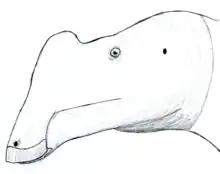 | |
| Archaeoceratops | 1997 | Xinminbao Group (Early Cretaceous, Barremian) | Had no horns and only the beginnings of a frill |  | |
| Archaeornithoides | 1992 | Djadochta Formation (Late Cretaceous, Campanian) | Known from only a partial skull with scratches that may have been created by a small mammal[9] |  | |
| Archaeornithomimus | 1972 | Bissekty Formation?, Iren Dabasu Formation (Late Cretaceous, Cenomanian to Turonian) | Unlike other ornithomimosaurs, its feet were not arctometatarsalian |  | |
| Arkharavia | 2010 | Udurchukan Formation (Late Cretaceous, Maastrichtian) | Described from a series of vertebrae, several of which were found to not belong to this taxon[10] |  | |
| Arstanosaurus | 1982 | Bostobe Formation (Late Cretaceous, Santonian to Campanian) | Poorly known | ||
| Asiaceratops | 1989 | Khodzhakul Formation, Xinminbao Group? (Late Cretaceous, Cenomanian) | Potentially a leptoceratopsid[11] | ||
| Asiatosaurus | 1924 | Öösh Formation, Xinlong Formation (Early Cretaceous, Barremian to Albian) | Two species have been named but both are only known from extremely scant remains |  | |
| Auroraceratops | 2005 | Xinminbao Group (Early Cretaceous, Aptian) | Known from more than eighty specimens, including complete skeletons |  | |
| Aurornis | 2013 | Tiaojishan Formation (Late Jurassic, Oxfordian) | If an avialan as originally described it would be one of the oldest members of the group |  | |
| Avimimus | 1981 | Barun Goyot Formation, Nemegt Formation (Late Cretaceous, Campanian to Maastrichtian) | Bonebed remains indicate a gregarious lifestyle; it may have formed age-segregated herds for lekking or flocking purposes[12] |  | |
| Bactrosaurus | 1933 | Iren Dabasu Formation, Majiacun Formation? (Late Cretaceous, Cenomanian to Santonian?) | Remains of at least six individuals are known, making up much of the skeleton |  | |
| Bagaceratops | 1975 | Barun Goyot Formation, Bayan Mandahu Formation, Djadochta Formation? (Late Cretaceous, Campanian to Maastrichtian) | May have been a direct descendant of Protoceratops which it physically resembles[13] |  | |
| Bagaraatan | 1996 | Nemegt Formation (Late Cretaceous, Maastrichtian) | Combines traits of several theropod groups, possibly due to being chimaeric[14] |  | |
| Bainoceratops | 2003 | Djadochta Formation (Late Cretaceous, Campanian) | Its supposedly diagnostic features may fall within Protoceratops variation[15] | ||
| Banji | 2010 | Nanxiong Formation (Late Cretaceous, Maastrichtian) | Vertical striations adorned the sides of its crest |  | |
| Bannykus | 2018 | Bayin-Gobi Formation (Early Cretaceous, Barremian to Aptian) | Exhibited a transitional hand morphology for an alvarezsaur, having three fingers of roughly equal length with the first being robust |  | |
| Baotianmansaurus | 2009 | Gaogou Formation (Late Cretaceous, Cenomanian to Turonian) | Large but known from only a few bones |  | |
| Barsboldia | 1981 | Nemegt Formation (Late Cretaceous, Maastrichtian) | Possessed elongated neural spines particularly above the hips | .jpg.webp) | |
| Bashanosaurus | 2022 | Shaximiao Formation (Middle Jurassic, Bajocian) | Its skeleton combines traits of stegosaurs and more basal thyreophorans | ||
| Bashunosaurus | 2004 | Shaximiao Formation (Middle Jurassic, Bathonian to Callovian) | Although described as a macronarian, this has yet to be rigorously tested[16] | ||
| Batyrosaurus | 2012 | Bostobe Formation (Late Cretaceous, Santonian to Campanian) | Remains originally identified as Arstanosaurus |  | |
| Bayannurosaurus | 2018 | Bayin-Gobi Formation (Early Cretaceous, Aptian) | Known from a well-preserved, almost complete skeleton |  | |
| Beg | 2020 | Ulaanoosh Formation (Early Cretaceous to Late Cretaceous, Albian to Cenomanian) | Its preserved skull has a rugose texture |  | |
| Beibeilong | 2017 | Gaogou Formation (Late Cretaceous, Cenomanian to Coniacian) | Similar to but more basal than Gigantoraptor.[17] Known from only a single embryo still in its egg |  | |
| Beipiaosaurus | 1999 | Yixian Formation (Early Cretaceous, Aptian) | Preserves evidence of downy feathers as well as a secondary coat of simpler "elongated broad filamentous feathers" or EBFFs[18] |  | |
| Beishanlong | 2010 | Xinminbao Group (Early Cretaceous, Aptian to Albian) | Lacked the elongated claws of more derived ornithomimosaurs |  | |
| Bellusaurus | 1990 | Shishugou Formation (Late Jurassic, Oxfordian) | Known from a bone bed with the remains of seventeen juvenile specimens |  | |
| Bienosaurus | 2001 | Lufeng Formation (Early Jurassic, Sinemurian) | Potentially synonymous with Tatisaurus[19] |  | |
| Bissektipelta | 2004 | Bissekty Formation (Late Cretaceous, Turonian to Coniacian) | Analysis of its braincase suggests poor hearing and eyesight but good olfaction and taste; it has been suggested to be a filter feeder[20] | ||
| Bolong | 2010 | Yixian Formation (Early Cretaceous, Aptian) | Originally known from only a skull; an almost complete skeleton was described in 2013[21] |  | |
| Borealosaurus | 2004 | Sunjiawan Formation (Late Cretaceous, Cenomanian to Turonian) | Its caudal vertebrae were distinctively opisthocoelous | ||
| Borogovia | 1987 | Nemegt Formation (Late Cretaceous, Maastrichtian) | Had a uniquely straight and flattened sickle claw, which may have had a weight-bearing function |  | |
| Breviceratops | 1990 | Barun Goyot Formation (Late Cretaceous, Campanian) | Only known from juvenile remains but can be distinguished from other protoceratopsids | 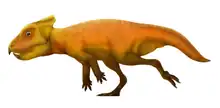 | |
| Brohisaurus | 2003 | Sembar Formation (Late Jurassic, Kimmeridgian) | Possibly an early titanosauriform | ||
| Byronosaurus | 2000 | Djadochta Formation (Late Cretaceous, Campanian) | Two juvenile skulls were found in an oviraptorid nest and claimed to be evidence for nest parasitism in this taxon, but both their identity and taphonomy have been questioned[4][22] |  | |
| Caenagnathasia | 1994 | Bissekty Formation (Late Cretaceous, Turonian to Coniacian) | One of the oldest and smallest known caenagnathoids |  | |
| Caihong | 2018 | Tiaojishan Formation (Late Jurassic, Oxfordian) | Possessed platelet-shaped melanosomes that produced iridesence as in modern trumpeters |  | |
| Caudipteryx | 1998 | Yixian Formation (Early Cretaceous, Barremian) | Two species are known. At least C. zoui did not have secondary feathers attached to the lower arm |  | |
| Ceratonykus | 2009 | Barun Goyot Formation (Late Cretaceous, Campanian) | Several osteological features were described as similar to ornithischians[23] |  | |
| Changchunsaurus | 2005 | Quantou Formation (Early Cretaceous to Late Cretaceous, Aptian to Cenomanian) | Had wavy enamel on its leaf-shaped teeth that made them more resistant to wear; this feature is also present in hadrosaurs[24] |  | |
| Changmiania | 2020 | Yixian Formation (Early Cretaceous, Barremian) | Preserved in a curled-up position as if sleeping in a potential burrow |  | |
| Changyuraptor | 2014 | Yixian Formation (Early Cretaceous, Barremian) | The largest microraptorian dromaeosaurid known. Had tail feathers almost a foot long[25] |  | |
| Chaoyangsaurus | 1999 | Tuchengzi Formation (Late Jurassic, Tithonian) | Known by a number of alternate spellings (e.g. Chaoyangosaurus, Chaoyoungosaurus) before its formal description |  | |
| Charonosaurus | 2000 | Yuliangze Formation (Late Cretaceous, Maastrichtian) | May have had a long, backwards-arcing crest similar to that of Parasaurolophus |  | |
| Chialingosaurus | 1959 | Shaximiao Formation (Late Jurassic, Oxfordian to Kimmeridgian) | Had both large plates and smaller spines, similar to Kentrosaurus |  | |
| Chiayusaurus | 1953 | Hasandong Formation, Xinminbao Group (Early Cretaceous, Barremian to Albian) | Two species have been named, both from teeth. Those of C. lacustris are apparently indistinguishable to those of Euhelopus[26] or Mamenchisaurus[27] | ||
| Chilantaisaurus | 1964 | Ulansuhai Formation (Late Cretaceous, Turonian) | Had a particularly hooked claw on its first finger |  | |
| Chingkankousaurus | 1958 | Wangshi Group (Late Cretaceous, Santonian to Campanian) | Known from only a scapula. Possibly a tyrannosauroid[28] | ||
| Chinshakiangosaurus | 1992 | Fengjiahe Formation (Early Jurassic, Hettangian) | Had a U-shaped snout that may have supported fleshy cheeks, an adaptation to bulk feeding | ||
| Choyrodon | 2018 | Khuren Dukh Formation (Early Cretaceous, Albian) | It had an enlarged nose similar to its contemporary, Altirhinus, but it is most likely a separate taxon[29] |  | |
| Chuandongocoelurus | 1984 | Shaximiao Formation (Middle Jurassic, Bathonian to Callovian) | A tetanuran of uncertain relationships |  | |
| Chuanjiesaurus | 2000 | Chuanjie Formation (Middle Jurassic, Bathonian) | One of the more derived mamenchisaurids[30] |  | |
| Chuanqilong | 2014 | Jiufotang Formation (Early Cretaceous, Barremian to Aptian) | May have been the adult form of the coeval Liaoningosaurus[31] |  | |
| Chungkingosaurus | 1983 | Shaximiao Formation (Late Jurassic, Oxfordian) | May have possessed at least six thagomizer spikes; the rearmost pair was mounted horizontally, directed outwards and backwards |  | |
| Chuxiongosaurus | 2010 | Lufeng Formation (Early Jurassic, Hettangian to Pliensbachian) | Potentially a synonym of Jingshanosaurus[32] | ||
| Citipati | 2001 | Djadochta Formation (Late Cretaceous, Campanian to Maastrichtian) | Had a distinctive triangular crest. A referred specimen known as the Zamyn Khondt oviraptorid possessed the familiar rectangular domed crest in most depictions of Oviraptor, but likely does not belong to that genus or Citipati[33] |  | |
| Conchoraptor | 1986 | Barun Goyot Formation, Nemegt Formation (Late Cretaceous, Maastrichtian) | Named for a hypothesized diet of shellfish, but this cannot be confirmed |  | |
| Corythoraptor | 2017 | Nanxiong Formation (Late Cretaceous, Maastrichtian) | Its crest was vertical and rectangular, not unlike that of a cassowary |  | |
| Crichtonpelta | 2015 | Sunjiawan Formation (Late Cretaceous, Cenomanian) | Originally named as a second species of Crichtonsaurus | ||
| Crichtonsaurus | 2002 | Sunjiawan Formation (Late Cretaceous, Cenomanian to Turonian) | Sometimes reconstructed with semicircular osteoderms vaguely similar to the plates of stegosaurs |  | |
| Daanosaurus | 2005 | Shaximiao Formation (Late Jurassic, Oxfordian to Tithonian) | Phylogenetic position is uncertain as it is only known from the remains of a juvenile | ||
| Daliansaurus | 2017 | Yixian Formation (Early Cretaceous, Barremian) | Had an enlarged claw on the fourth toe comparable in size to the sickle claw on its second |  | |
| Dashanpusaurus | 2005 | Shaximiao Formation (Middle Jurassic, Callovian) | One of the basalmost and earliest known macronarians[34] | ||
| Datanglong | 2014 | Xinlong Formation (Early Cretaceous, Barremian to Albian) | Had a uniquely pneumatized ilium similar to megaraptorans | ||
| Datonglong | 2016 | Huiquanpu Formation (Late Cretaceous, Cenomanian to Campanian) | Precise dating uncertain | ||
| Datousaurus | 1984 | Shaximiao Formation (Middle Jurassic to Late Jurassic, Bathonian to Oxfordian) | One of the rarer sauropods of the Shaximiao, known from only two skeletons and a large, deep skull |  | |
| Daurlong | 2022 | Longjiang Formation (Early Cretaceous, Aptian) | Preserves remains of an intestinal tract |  | |
| Daxiatitan | 2008 | Hekou Group (Early Cretaceous, Barremian) | Large and very long-necked |  | |
| Deinocheirus | 1970 | Nemegt Formation (Late Cretaceous, Maastrichtian) | Had a suite of unique features, most notably a hump supported by elongated neural spines |  | |
| Dilong | 2004 | Yixian Formation (Early Cretaceous, Barremian) | Preserves evidence of a coating of simple feathers |  | |
| Dongbeititan | 2007 | Yixian Formation (Early Cretaceous, Barremian) | A theropod tooth has been found encrusted in one of its ribs[35] |  | |
| Dongyangopelta | 2013 | Chaochuan Formation (Early Cretaceous to Late Cretaceous, Albian to Cenomanian) | Coexisted with Zhejiangosaurus but could be distinguished based on subtle osteological features[36] | ||
| Dongyangosaurus | 2008 | Jinhua Formation (Late Cretaceous, Turonian to Coniacian) | Its phylogenetic placement is uncertain | .jpg.webp) | |
| Dzharaonyx | 2022 | Bissekty Formation (Late Cretaceous, Turonian) | One of the oldest known parvicursorines | ||
| Dzharatitanis | 2021 | Bissekty Formation (Late Cretaceous, Turonian) | Originally described as a rebbachisaurid[37] but later reinterpreted as a titanosaur with possible lognkosaurian affinities[38] |  | |
| Elmisaurus | 1981 | Nemegt Formation (Late Cretaceous, Maastrichtian) | One of the most complete caenagnathids known |  | |
| Embasaurus | 1931 | Neocomian Sands (Early Cretaceous, Berriasian) | Known from only two vertebrae |  | |
| Enigmosaurus | 1983 | Bayan Shireh Formation (Late Cretaceous, Cenomanian to Santonian) | Had a large, backwards-pointing pelvis |  | |
| Eomamenchisaurus | 2008 | Zhanghe Formation (Middle Jurassic to Late Jurassic, Aalenian to Oxfordian) | One of the oldest mamenchisaurids | ||
| Eosinopteryx | 2013 | Tiaojishan Formation (Late Jurassic, Oxfordian) | Described as lacking advanced tail feathers and long "hind wings", unlike other paravians, but this may be an artifact of preservation[39] |  | |
| Epidexipteryx | 2008 | Haifanggou Formation (Middle Jurassic, Callovian) | Supported four long feathers from an abbreviated tail |  | |
| Equijubus | 2003 | Xinminbao Group (Early Cretaceous, Albian) | A grazer that preserves the oldest known evidence of grass-eating[40] |  | |
| Erketu | 2006 | Bayan Shireh Formation (Late Cretaceous, Cenomanian to Santonian) | May have had the longest neck of any dinosaur relative to its body |  | |
| Erliansaurus | 2002 | Iren Dabasu Formation (Late Cretaceous, Cenomanian) | Had long, curved claws on its fingers |  | |
| Erlikosaurus | 1980 | Bayan Shireh Formation (Late Cretaceous, Cenomanian to Santonian) | Preserves the most complete skull known from any therizinosaur |  | |
| Eshanosaurus | 2001 | Lufeng Formation (Early Jurassic, Hettangian) | Has been suggested to be the oldest known therizinosaur |  | |
| Euhelopus | 1956 | Meng-Yin Formation (Early Cretaceous, Berriasian to Valanginian) | Originally believed to have lived in a marshy environment |  | |
| Euronychodon | 1991 | Bissekty Formation (Late Cretaceous, Turonian) | Type species was found in Portugal. The Asian species may represent a form taxon of improperly developed teeth[41] | ||
| Ferganasaurus | 2003 | Balabansai Formation (Middle Jurassic, Callovian) | Claimed to have two hand claws, but this is disputed[42] | ||
| Ferganocephale | 2005 | Balabansai Formation (Middle Jurassic, Callovian) | Unusually, its teeth were not serrated | ||
| Fujianvenator | 2023 | Nanyuan Formation (Late Jurassic, Tithonian) | Possessed proportionally long legs which may be an adaptation to wading |  | |
| Fukuiraptor | 2000 | Kitadani Formation, Sebayashi Formation? (Early Cretaceous, Barremian to Aptian) | Similarly to Megaraptor, it was originally reconstructed as a dromaeosaur with its hand claw on its foot |  | |
| Fukuisaurus | 2003 | Kitadani Formation (Early Cretaceous, Barremian) | The elements of its skull are so strongly fused that it was unable to chew[43] |  | |
| Fukuititan | 2010 | Kitadani Formation (Early Cretaceous, Barremian to Aptian) | The first sauropod named from Japan |  | |
| Fukuivenator | 2016 | Kitadani Formation (Early Cretaceous, Barremian to Aptian) | Possesses traits of various groups of coelurosaurs, though probably a therizinosaur.[44] May have been a herbivore or omnivore due to its heterodont dentition | .png.webp) | |
| Fulengia | 1977 | Lufeng Formation (Early Jurassic, Hettangian to Toarcian) | May have been a juvenile Lufengosaurus | ||
| Fushanosaurus | 2019 | Shishugou Formation (Late Jurassic, Oxfordian) | Known from a single femur of immense size | ||
| Fusuisaurus | 2006 | Xinlong Formation (Early Cretaceous, Aptian to Albian) | A referred humerus may support an extremely large size for this taxon[45] | ||
| Gallimimus | 1972 | Nemegt Formation (Late Cretaceous, Maastrichtian) | Had a relatively long beak with a rounded tip |  | |
| Gannansaurus | 2013 | Nanxiong Formation (Late Cretaceous, Maastrichtian) | Its vertebrae were more similar to those of Euhelopus than to other sauropods | 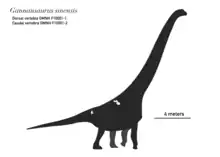 | |
| Ganzhousaurus | 2013 | Nanxiong Formation (Late Cretaceous, Maastrichtian) | Coexisted with at least seven other oviraptorosaurs, which may have niche-partitioned. It was likely primarily herbivorous[46] |  | |
| Garudimimus | 1981 | Bayan Shireh Formation (Late Cretaceous, Cenomanian to Santonian) | Was not as well-adapted to running as later ornithomimosaurs |  | |
| Gasosaurus | 1985 | Shaximiao Formation (Middle Jurassic, Bathonian to Callovian) | Discovered as a byproduct of construction work |  | |
| Gigantoraptor | 2007 | Iren Dabasu Formation (Late Cretaceous, Cenomanian) | The largest known oviraptorosaur, comparable in size to Albertosaurus |  | |
| Gigantspinosaurus | 1992 | Shaximiao Formation (Late Jurassic, Oxfordian) | Possessed broad, greatly enlarged shoulder spines |  | |
| Gilmoreosaurus | 1979 | Bissekty Formation?, Iren Dabasu Formation, Khodzhakul Formation? (Late Cretaceous, Cenomanian) | Several fossils preserve evidence of cancer-induced tumors[47] |  | |
| Gobihadros | 2019 | Bayan Shireh Formation (Late Cretaceous, Cenomanian to Santonian) | Known from multiple specimens representing different growth stages |  | |
| Gobiraptor | 2019 | Nemegt Formation (Late Cretaceous, Maastrichtian) | Possessed a deep jaw that may be an adaptation to crushing bivalves or seeds[48] |  | |
| Gobisaurus | 2001 | Ulansuhai Formation (Late Cretaceous, Turonian) | Had no tail club but already possessed the stiff tail of derived ankylosaurids[49] |  | |
| Gobititan | 2003 | Xinminbao Group (Early Cretaceous, Aptian) | Retained the fifth digit of the foot, a basal trait | ||
| Gobivenator | 2014 | Djadochta Formation (Late Cretaceous, Campanian) | The most completely known Cretaceous troodontid |  | |
| Gongbusaurus | 1983 | Shaximiao Formation (Late Jurassic, Oxfordian) | Only known from a pair of teeth. May be an ankylosaurian[50] | ||
| Gongpoquansaurus | 2014 | Xinminbao Group (Early Cretaceous, Albian) | Remains originally named as a species of Probactrosaurus |  | |
| Gongxianosaurus | 1998 | Ziliujing Formation (Early Jurassic, Toarcian) | The only sauropod with ossified distal tarsals, hinting at its basal position | ||
| Goyocephale | 1982 | Unnamed formation (Late Cretaceous, Campanian) | Had a sloping head with a flat skull roof |  | |
| Graciliceratops | 2000 | Bayan Shireh Formation (Late Cretaceous, Santonian) | Possessed a short frill with large fenestrae |  | |
| Graciliraptor | 2004 | Yixian Formation (Early Cretaceous, Barremian) | A close relative of Microraptor with characteristically slender bones |  | |
| Guanlong | 2006 | Shishugou Formation (Late Jurassic, Oxfordian) | Two specimens have been discovered, one on top of the other |  | |
| Halszkaraptor | 2017 | Djadochta Formation (Late Cretaceous, Campanian) | Originally interpreted as a semiaquatic fish hunter similar to a merganser[51] but this hypothesis has been criticized[52] |  | |
| Hamititan | 2021 | Shengjinkou Formation (Early Cretaceous, Aptian) | Known from seven caudal vertebrae and associated elements |  | |
| Haplocheirus | 2010 | Shishugou Formation (Late Jurassic, Oxfordian) | Possessed three long fingers with short claws. Originally described as a basal alvarezsauroid but similarities have been noted with other coelurosaurs[14][53] |  | |
| Harpymimus | 1984 | Khuren Dukh Formation?/Shinekhudag Formation? (Early Cretaceous, Albian) | Mostly toothless but retains a few teeth in the dentary |  | |
| Haya | 2011 | Javkhlant Formation (Late Cretaceous, Santonian to Campanian) | One specimen preserves a large mass of gastroliths |  | |
| Heishansaurus | 1953 | Minhe Formation (Late Cretaceous, Campanian to Maastrichtian) | May be a junior synonym of Pinacosaurus[54] | ||
| Helioceratops | 2009 | Quantou Formation (Early Cretaceous to Late Cretaceous, Aptian to Cenomanian) | Had a distinctively short lower jaw |  | |
| Hexing | 2012 | Yixian Formation (Early Cretaceous, Valanginian to Barremian) | Three or four teeth are known, but they are not well-preserved |  | |
| Hexinlusaurus | 2005 | Shaximiao Formation (Middle Jurassic, Bajocian) | Originally named as a species of Yandusaurus |  | |
| Heyuannia | 2002 | Barun Goyot Formation, Dalangshan Formation (Late Cretaceous, Maastrichtian) | Fossilized pigments in referred eggshells suggest they were blue-green[55] |  | |
| Homalocephale | 1974 | Nemegt Formation (Late Cretaceous, Maastrichtian) | Has been suggested to be a juvenile Prenocephale on account of its flat head,[56] but this is no longer thought to be the case[57] |  | |
| Huabeisaurus | 2000 | Huiquanpu Formation (Late Cretaceous, Cenomanian to Maastrichtian) | May be closely related to Tangvayosaurus[58] |  | |
| Hualianceratops | 2015 | Shishugou Formation (Late Jurassic, Oxfordian) | Had a series of bumps around the edge of the beak |  | |
| Huanansaurus | 2015 | Nanxiong Formation (Late Cretaceous, Campanian to Maastrichtian) | Possessed a distinctive short trapezoidal crest | 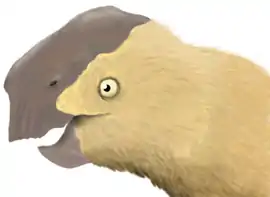 | |
| Huanghetitan | 2006 | Haoling Formation, Hekou Group (Early Cretaceous, Aptian to Albian) | Had ribs 3 metres (9.8 ft) long, which supported one of the deepest body cavities of any dinosaur[59] | 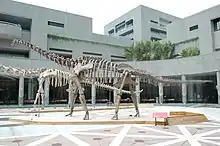 | |
| Huangshanlong | 2014 | Hongqin Formation (Middle Jurassic to Late Jurassic, Aalenian to Oxfordian) | Known from some bones of the right forelimb |  | |
| Huaxiagnathus | 2004 | Yixian Formation (Early Cretaceous, Aptian) | One of the largest known compsognathids |  | |
| Huayangosaurus | 1982 | Shaximiao Formation (Middle Jurassic, Bathonian to Callovian) | Possessed flank osteoderms and a small tail club in addition to plates and spikes |  | |
| Hudiesaurus | 1997 | Kalaza Formation (Late Jurassic, Tithonian) | Had a butterfly-shaped process on its vertebra |  | |
| Hulsanpes | 1982 | Barun Goyot Formation (Late Cretaceous, Campanian) | Closely related to Halszkaraptor but appears to be more cursorial[60] |  | |
| Ichthyovenator | 2012 | Grès supérieurs Formation (Early Cretaceous, Aptian) | One of its sacral vertebrae was greatly reduced, giving the illusion of a break in its sail or of two separate sails |  | |
| Incisivosaurus | 2002 | Yixian Formation (Early Cretaceous, Barremian) | Two specimens of different ontogenetic stages are known, both with differing types of feathers[61] | .png.webp) | |
| Irisosaurus | 2020 | Fengjiahe Formation (Early Jurassic, Hettangian) | Closely related to Mussaurus[62] |  | |
| Isanosaurus | 2000 | Nam Phong Formation (Late Triassic, Norian to Rhaetian) | May have actually come from the Late Jurassic[63] | .jpg.webp) | |
| Ischioceratops | 2015 | Wangshi Group (Late Cretaceous, Campanian to Maastrichtian) | Noted for its peculiarly-shaped ischium |  | |
| Itemirus | 1976 | Bissekty Formation (Late Cretaceous, Turonian) | Originally known from a braincase but abundant new remains were described in 2014[64] |  | |
| Jaculinykus | 2023 | Barun Goyot Formation (Late Cretaceous, Maastrichtian) | Was didactyl, with a large first finger and a reduced second finger |  | |
| Jaxartosaurus | 1937 | Dabrazhin Formation (Late Cretaceous, Santonian) | Not known from many remains but they are enough to tell that it was a basal lambeosaurine[65] |  | |
| Jeholosaurus | 2000 | Yixian Formation (Early Cretaceous, Aptian) | One specimen is preserved in a curled position |  | |
| Jianchangosaurus | 2013 | Yixian Formation (Early Cretaceous, Barremian) | Several characters of its teeth and jaws are convergently similar to those of ornithischians[66] |  | |
| Jiangjunosaurus | 2007 | Shishugou Formation (Late Jurassic, Oxfordian) | Had two rows of circular or diamond-shaped plates | ||
| Jiangshanosaurus | 2001 | Jinhua Formation (Late Cretaceous, Turonian to Coniacian) | A potential member of the Euhelopodidae[67] | 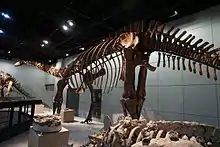 | |
| Jiangxisaurus | 2013 | Nanxiong Formation (Late Cretaceous, Maastrichtian) | Overall similar to Heyuannia but with a thinner, frailer mandible |  | |
| Jiangxititan | 2023 | Nanxiong Formation (Late Cretaceous, Maastrichtian) | Described as one of the few known lognkosaurs from mainland Asia |  | |
| Jianianhualong | 2017 | Yixian Formation (Early Cretaceous, Aptian) | Possessed a subtriangular tail frond made of asymmetrical feathers, although it was most likely flightless |  | |
| Jinbeisaurus | 2019 | Huiquanpu Formation (Late Cretaceous, Cenomanian to Maastrichtian) | A medium-sized tyrannosauroid | ||
| Jinfengopteryx | 2005 | Huajiying Formation (Early Cretaceous, Barremian) | May have been capable of some sort of flight[68] |  | |
| Jingshanosaurus | 1995 | Lufeng Formation (Early Jurassic, Hettangian) | One of the latest-surviving non-sauropod sauropodomorphs |  | |
| Jintasaurus | 2009 | Xinminbao Group (Early Cretaceous, Albian) | Known from only the rear half of a skull, including a complete braincase | 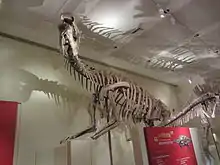 | |
| Jinyunpelta | 2018 | Liangtoutang Formation (Early Cretaceous to Late Cretaceous, Albian to Cenomanian) | The oldest ankylosaurid known to have a tail club |  | |
| Jinzhousaurus | 2001 | Yixian Formation (Early Cretaceous, Aptian) | Its holotype is nearly complete, preserved whole on a single slab |  | |
| Jiutaisaurus | 2006 | Quantou Formation (Early Cretaceous to Late Cretaceous, Barremian to Cenomanian) | Named based on eighteen vertebrae | ||
| Kaijiangosaurus | 1984 | Shaximiao Formation (Middle Jurassic, Bathonian to Callovian) | Potentially synonymous with other medium-sized Shaximiao theropods |  | |
| Kamuysaurus | 2019 | Hakobuchi Formation (Late Cretaceous, Maastrichtian) | Informally referred to as "Mukawaryu" before its formal description |  | |
| Kansaignathus | 2021 | Ialovachsk Formation (Late Cretaceous, Santonian) | The first non-avian dinosaur described from Tajikistan |  | |
| Kazaklambia | 2013 | Dabrazhin Formation (Late Cretaceous, Santonian) | Morphologically distinct from other Eurasian lambeosaurines[69] |  | |
| Kelmayisaurus | 1973 | Lianmuqin Formation (Early Cretaceous, Valanginian to Albian) | One popular book mentions a giant species belonging to this genus,[70] but this referral may be incorrect |  | |
| Kerberosaurus | 2004 | Tsagayan Formation (Late Cretaceous, Maastrichtian) | Potentially a close relative of Edmontosaurus[71] |  | |
| Khaan | 2001 | Djadochta Formation (Late Cretaceous, Campanian) | Two morphotypes of chevrons are known, which may be a sexually dimorphic trait[72] |  | |
| Khulsanurus | 2021 | Barun Goyot Formation (Late Cretaceous, Campanian) | Contemporary with Parvicursor but can be distinguished by characters of its caudal vertebrae[73] | ||
| Kileskus | 2010 | Itat Formation (Middle Jurassic, Bathonian) | Uncertain if it possesses the head crest as seen in other proceratosaurids |  | |
| Kinnareemimus | 2009 | Sao Khua Formation (Early Cretaceous, Valanginian to Barremian) | Potentially one of the oldest ornithomimosaurs |  | |
| Klamelisaurus | 1993 | Shishugou Formation (Middle Jurassic, Callovian) | Close relatives included several referred species of Mamenchisaurus[74] |  | |
| Kol | 2009 | Djadochta Formation (Late Cretaceous, Campanian) | Had a "hyperarctometatarsus" more strongly pinched than other arctometatarsalian taxa. Described as an alvarezsaurid[75] but has been suggested to be related to Avimimus[76] | ||
| Koreaceratops | 2011 | Sihwa Formation (Early Cretaceous, Albian) | Possessed elongated neural spines on its caudal vertebrae. Its describers suggest that it was used as a swimming organ,[77] but a later study found it to live in a semiarid environment, making this unlikely[78] |  | |
| Koreanosaurus | 2011 | Seonso Conglomerate (Late Cretaceous, Campanian) | Had short but powerful forelimbs suggesting it may have been a quadruped[79] |  | |
| Koshisaurus | 2015 | Kitadani Formation (Early Cretaceous, Hauterivian) | Distinguished from other hadrosauroids by the presence of an antorbital fossa |  | |
| Kulceratops | 1995 | Khodzhakul Formation (Early Cretaceous, Albian) | Only known from fragments of a jaw and teeth |  | |
| Kulindadromeus | 2014 | Ukureyskaya Formation (Middle Jurassic, Bathonian) | An ornithischian that preserves evidence of filaments, suggesting that protofeathers were basal to Dinosauria as a whole |  | |
| Kundurosaurus | 2012 | Udurchukan Formation (Late Cretaceous, Maastrichtian) | May be synonymous with Kerberosaurus[80] |  | |
| Kuru | 2021 | Barun Goyot Formation (Late Cretaceous, Maastrichtian) | Had been informally referred to as "Airakoraptor" prior to its formal description |  | |
| Laiyangosaurus | 2019 | Wangshi Group (Late Cretaceous, Maastrichtian) | Some specimens referred to this edmontosaurin actually belong to kritosaurins and lambeosaurines[81] |  | |
| Lanzhousaurus | 2005 | Hekou Group (Early Cretaceous, Barremian) | Possessed the largest known teeth of any dinosaur |  | |
| Leshansaurus | 2009 | Shaximiao Formation (Late Jurassic, Oxfordian to Kimmeridgian) | Its braincase is nearly identical to that of Piveteausaurus[82] |  | |
| Levnesovia | 2009 | Bissekty Formation (Late Cretaceous, Turonian) | One of the smallest known hadrosauroids[42] | ||
| Liaoceratops | 2002 | Yixian Formation (Early Cretaceous, Barremian) | One specimen was found without a skull roof, possibly displaced by a predator to eat its brain[83] |  | |
| Liaoningosaurus | 2001 | Yixian Formation (Early Cretaceous, Barremian to Aptian) | One specimen has been interpreted as possessing fork-like teeth, sharp claws, and stomach contents including fish, which has been claimed to be evidence of a semi-aquatic, turtle-like lifestyle[84] |  | |
| Liaoningotitan | 2018 | Yixian Formation (Early Cretaceous, Barremian) | The second sauropod named from the Yixian Formation | ||
| Liaoningvenator | 2017 | Yixian Formation (Early Cretaceous, Barremian) | Uniquely preserved with the head curving forwards, differing from the classic theropod "death pose" and the sleeping position of other troodontids |  | |
| Limusaurus | 2009 | Shishugou Formation (Late Jurassic, Oxfordian) | Multiple specimens from different growth stages are known. Juveniles possessed teeth which were lost and replaced with a beak as adults, suggesting a change in diet[85] |  | |
| Lingwulong | 2018 | Yanan Formation?/Zhiluo Formation? (Middle Jurassic to Late Jurassic, Aalenian to Oxfordian) | The first confirmed diplodocoid from Asia. Originally considered Early Jurassic, making it the oldest known neosauropod, but this age has been disputed[86][87] |  | |
| Lingyuanosaurus | 2019 | Jiufotang Formation?/Yixian Formation? (Early Cretaceous, Valanginian to Aptian) | Possessed a mix of basal and derived therizinosaurian traits |  | |
| Linhenykus | 2011 | Bayan Mandahu Formation (Late Cretaceous, Campanian to Maastrichtian) | Completely monodactyl due to lacking the vestigial second and third fingers of other alvarezsaurids |  | |
| Linheraptor | 2010 | Bayan Mandahu Formation (Late Cretaceous, Campanian) | Potentially a synonym of Tsaagan[88] |  | |
| Linhevenator | 2011 | Bayan Mandahu Formation (Late Cretaceous, Campanian) | Had a greatly enlarged sickle claw, comparable in size to those of dromaeosaurids |  | |
| Liubangosaurus | 2010 | Xinlong Formation (Early Cretaceous, Barremian to Aptian) | Described only as a eusauropod[89] but has since been reinterpreted as a somphospondylian[90] | ||
| Luanchuanraptor | 2007 | Qiupa Formation (Late Cretaceous, Maastrichtian) | The first Asian dromaeosaurid found outside the Gobi Desert and northeastern China. May have been closely related to Adasaurus[14] |  | |
| Lufengosaurus | 1940 | Lufeng Formation (Early Jurassic, Hettangian to Sinemurian) | The rib of one specimen preserves the oldest known evidence of collagen proteins[91] |  | |
| Luoyanggia | 2009 | Haoling Formation (Early Cretaceous, Aptian to Albian) | Originally believed to date from the Late Cretaceous | ||
| Machairasaurus | 2010 | Bayan Mandahu Formation (Late Cretaceous, Campanian) | Its hand claws are elongated and blade-like in side view |  | |
| Mahakala | 2007 | Djadochta Formation (Late Cretaceous, Campanian) | Possessed basal traits for a dromaeosaurid. May be a close relative of Halszkaraptor[92] |  | |
| Maleevus | 1987 | Bayan Shireh Formation (Late Cretaceous, Cenomanian to Santonian) | Its only purportedly distinguishing trait is also shared with Pinacosaurus[36] | ||
| Mamenchisaurus | 1954 | Penglaizhen Formation, Shaximiao Formation, Shishugou Formation, Suining Formation (Late Jurassic to Early Cretaceous, Oxfordian to Aptian) | Several species have been named, but most may not belong to this genus[74] |  | |
| Mandschurosaurus | 1930 | Grès supérieurs Formation?, Yuliangze Formation (Late Cretaceous, Maastrichtian) | One of the first non-avian dinosaurs named from Chinese remains |  | |
| Mei | 2004 | Yixian Formation (Early Cretaceous, Aptian) | Two specimens are preserved in bird-like sleeping positions[93] |  | |
| Microceratus | 2008 | Ulansuhai Formation (Late Cretaceous, Turonian) | Originally named Microceratops, although that genus name is preoccupied by a wasp |  | |
| Microhadrosaurus | 1979 | Nanxiong Formation (Late Cretaceous, Maastrichtian) | Reportedly an unusually small hadrosaurid | ||
| Micropachycephalosaurus | 1978 | Wangshi Group (Late Cretaceous, Campanian to Maastrichtian) | Once considered to be a pachycephalosaur, although it is now usually considered to be a ceratopsian[94] |  | |
| Microraptor | 2000 | Jiufotang Formation (Early Cretaceous, Aptian) | Known from over three hundred fossils.[95] Several are well-preserved enough to reveal fine details such as feather covering and an iridescent black coloration[96] |  | |
| Migmanychion | 2023 | Longjiang Formation (Early Cretaceous, Aptian) | Its hand combines features of multiple groups of coelurosaurs |  | |
| Minimocursor | 2023 | Phu Kradung Formation (Late Jurassic, Tithonian) | The first basal neornithischian known from southeastern Asia |  | |
| Minotaurasaurus | 2009 | Djadochta Formation (Late Cretaceous, Campanian) | The holotype skull was excavated illegally, which obscured its true provenance until recently |  | |
| Mongolosaurus | 1933 | On Gong Formation (Early Cretaceous, Aptian to Albian) | Known from only scant remains but has been confidently assigned to Somphospondyli in recent years[90] |  | |
| Mongolostegus | 2018 | Dzunbain Formation (Early Cretaceous, Aptian to Albian) | Informally assigned to the genus Wuerhosaurus before its formal description |  | |
| Monkonosaurus | 1986 | Loe-ein Formation?/Lura Formation? (Late Jurassic, Oxfordian to Kimmeridgian?/Early Cretaceous, Albian?) | Poorly known | ||
| Monolophosaurus | 1993 | Shishugou Formation (Middle Jurassic, Bathonian to Callovian) | Possessed a short, rectangular crest running along the midline of the skull |  | |
| Mononykus | 1993 | Nemegt Formation (Late Cretaceous, Maastrichtian) | Proposed to have an anteater-like lifestyle, using its unique forearms to break into termite mounds[97] |  | |
| Mosaiceratops | 2015 | Xiaguan Formation (Late Cretaceous, Turonian to Campanian) | Combined features of different groups of basal ceratopsians |  | |
| Nankangia | 2013 | Nanxiong Formation (Late Cretaceous, Maastrichtian) | May have specialized in soft foods such as leaves and seeds[98] |  | |
| Nanningosaurus | 2007 | Unnamed formation (Late Cretaceous, Maastrichtian) | Potentially a basal lambeosaurine | ||
| Nanshiungosaurus | 1979 | Nanxiong Formation (Late Cretaceous, Maastrichtian) | Originally misidentified as a sauropod on account of its unusual pelvis |  | |
| Nanyangosaurus | 2000 | Xiaguan Formation (Late Cretaceous, Turonian to Campanian) | Completely lost the first digit of its hands |  | |
| Napaisaurus | 2022 | Xinlong Formation (Early Cretaceous, Aptian to Albian) | May be closely related to contemporary Thai iguanodonts | ||
| Natovenator | 2022 | Barun Goyot Formation (Late Cretaceous, Maastrichtian) | Possessed a streamlined body and a long, toothed snout, convergently similar to several groups of aquatic vertebrates |  | |
| Nebulasaurus | 2015 | Zhanghe Formation (Middle Jurassic, Aalenian to Bajocian) | Only known from a single braincase, but it is enough to tell that it was related to Spinophorosaurus |  | |
| Neimongosaurus | 2001 | Iren Dabasu Formation (Late Cretaceous, Cenomanian) | Could extend its arms considerably forward due to the structure of its shoulder joint[99] | 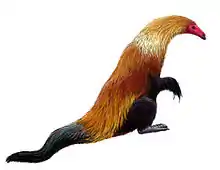 | |
| Nemegtomaia | 2005 | Barun Goyot Formation, Nemegt Formation (Late Cretaceous, Campanian to Maastrichtian) | One specimen preserves traces of damage by skin beetles[100] |  | |
| Nemegtonykus | 2019 | Nemegt Formation (Late Cretaceous, Campanian to Maastrichtian) | The second alvarezsaurid named from the Nemegt Formation |  | |
| Nemegtosaurus | 1971 | Nemegt Formation, Subashi Formation? (Late Cretaceous, Maastrichtian) | Had a long, low skull similar in proportions to those of diplodocoids |  | |
| Ningyuansaurus | 2012 | Yixian Formation (Early Cretaceous, Aptian) | Preserves small oval-shaped structures in its stomach region which may be seeds | ||
| Nipponosaurus | 1936 | Yezo Group (Late Cretaceous, Santonian to Campanian) | Discovered on the island of Sakhalin, which was owned by Japan in 1936 but later annexed by Russia |  | |
| Oksoko | 2020 | Nemegt Formation (Late Cretaceous, Maastrichtian) | Its third finger was so greatly reduced that it was functionally didactyl |  | |
| Olorotitan | 2003 | Udurchukan Formation (Late Cretaceous, Maastrichtian) | Had a broad, hatchet-shaped crest |  | |
| Omeisaurus | 1939 | Shaximiao Formation (Middle Jurassic, Bathonian to Callovian) | Members of this genus are characterized by extremely elongated necks |  | |
| Ondogurvel | 2022 | Barun Goyot Formation (Late Cretaceous, (Campanian) | Known from well-preserved remains of the hands and feet |  | |
| Opisthocoelicaudia | 1977 | Nemegt Formation (Late Cretaceous, Campanian to Maastrichtian) | Walked on its metacarpals due to its complete lack of phalanges |  | |
| Oviraptor | 1924 | Djadochta Formation (Late Cretaceous, Campanian to Maastrichtian) | Originally mistakenly thought to be an egg-eater |  | |
| Pachysuchus | 1951 | Lufeng Formation (Early Jurassic, Sinemurian to Pliensbachian) | Considered a phytosaur from its original naming until a redescription in 2012[101] | ||
| Panguraptor | 2014 | Lufeng Formation (Early Jurassic, Hettangian to Sinemurian) | The first definitive coelophysoid known from Asia | ||
| Papiliovenator | 2021 | Bayan Mandahu Formation (Late Cretaceous, Campanian) | Had a short, subtriangular skull similar to those of Early Cretaceous troodontids |  | |
| Paralitherizinosaurus | 2022 | Yezo Group (Late Cretaceous, Campanian | Had stiffened claws that may have been used to pull vegetation to the mouth[102] |  | |
| Parvicursor | 1996 | Barun Goyot Formation (Late Cretaceous, Campanian) | Originally believed to represent a diminutive adult dinosaur, although it was recently reinterpreted as a juvenile[103] |  | |
| Pedopenna | 2005 | Haifanggou Formation (Middle Jurassic, Callovian) | Known from a single leg with the impressions of long, symmetrical feathers |  | |
| Peishansaurus | 1953 | Minhe Formation (Late Cretaceous, Santonian to Campanian) | Has been compared to thyreophorans and marginocephalians, but it is impossible to determine which assignment is correct | ||
| Penelopognathus | 2005 | Bayin-Gobi Formation (Early Cretaceous, Albian) | Named from a single dentary | ||
| Phaedrolosaurus | 1973 | Lianmuqin Formation (Early Cretaceous, Valanginian to Albian) | May have been a dromaeosaurid[104] | ||
| Philovenator | 2012 | Bayan Mandahu Formation (Late Cretaceous, Campanian) | Closely related to the contemporary Linhevenator[93] but likely represents a separate taxon[105] |  | |
| Phuwiangosaurus | 1994 | Sao Khua Formation (Early Cretaceous, Valanginian to Hauterivian) | A large member of the Euhelopodidae[90] |  | |
| Phuwiangvenator | 2019 | Sao Khua Formation (Early Cretaceous, Barremian) | Combines features of both allosauroids and coelurosaurs[106] | 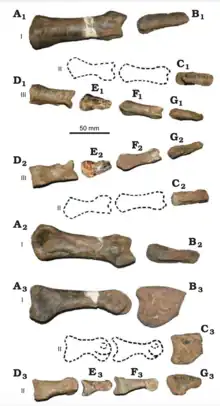 | |
| Pinacosaurus | 1933 | Bayan Mandahu Formation, Djadochta Formation (Late Cretaceous, Santonian to Campanian) | May have been capable of bird-like vocalizations[107] |  | |
| Plesiohadros | 2014 | Alagteeg Formation (Late Cretaceous, Campanian) | The first hadrosauroid known from the Alagteeg Formation | ||
| Prenocephale | 1974 | Nemegt Formation (Late Cretaceous, Maastrichtian) | Had a distinctively conical dome |  | |
| Probactrosaurus | 1966 | Dashuigou Formation (Early Cretaceous, Albian) | The closest relative to the Hadrosauromorpha based on the definition of the group[108] |  | |
| Prodeinodon | 1924 | Öösh Formation, Xinlong Formation (Early Cretaceous, Barremian to Aptian) | Potentially a carnosaur[109] | ||
| Protarchaeopteryx | 1997 | Yixian Formation (Early Cretaceous, Aptian) | Usually thought to be a basal oviraptorosaur but one study suggests a basal position within Pennaraptora[14] |  | |
| Protoceratops | 1923 | Bayan Mandahu Formation, Djadochta Formation (Late Cretaceous, Campanian) | Its remains are so abundant that it has been nicknamed the "sheep of the Cretaceous" |  | |
| Protognathosaurus | 1991 | Shaximiao Formation (Middle Jurassic, Bathonian to Callovian) | Originally named Protognathus, but that is preoccupied by an extinct beetle[110] | ||
| Psittacosaurus | 1923 | Andakhuduk Formation, Bayin-Gobi Formation, Ejinhoro Formation, Ilek Formation, Jiufotang Formation, Khok Kruat Formation, Öösh Formation, Qingshan Formation, Tugulu Group, Xinminbao Group, Yixian Formation (Early Cretaceous, Barremian to Albian) | Known from hundreds of specimens, many of them well-preserved. Lived in a broad range |  | |
| Pukyongosaurus | 2001 | Hasandong Formation (Early Cretaceous, Aptian to Albian) | One of its caudal vertebrae has bite marks caused by theropod teeth |  | |
| Qianlong | 2023 | Ziliujing Formation (Early Jurassic, Sinemurian) | Associated with fossils of leathery eggs, the oldest of their kind in the world |  | |
| Qianzhousaurus | 2014 | Nanxiong Formation (Late Cretaceous, Maastrichtian) | Has been nicknamed "Pinocchio rex" on account of its elongated snout |  | |
| Qiaowanlong | 2009 | Xinminbao Group (Early Cretaceous, Albian) | Originally described as a brachiosaurid[111] but has since been reinterpreted as a euhelopodid[112] |  | |
| Qijianglong | 2015 | Suining Formation (Early Cretaceous, Aptian) | Once believed to date from the Late Jurassic | ||
| Qingxiusaurus | 2008 | Unnamed formation (Late Cretaceous, Maastrichtian) | Known from very limited remains | ||
| Qinlingosaurus | 1996 | Hongtuling Formation?/Shanyang Formation? (Late Cretaceous, Maastrichtian) | Potentially a titanosaur given its age, but this cannot be confirmed |  | |
| Qiupalong | 2011 | Qiupa Formation (Late Cretaceous, Campanian to Maastrichtian) | A referred specimen was found in Canada[113] |  | |
| Qiupanykus | 2018 | Qiupa Formation (Late Cretaceous, Maastrichtian) | May have used its robust thumb claws to crack open oviraptorid eggshells[114] | ||
| Quaesitosaurus | 1983 | Barun Goyot Formation (Late Cretaceous, Maastrichtian) | Potentially a close relative of Nemegtosaurus |  | |
| Ratchasimasaurus | 2011 | Khok Kruat Formation (Early Cretaceous, Aptian) | Only known from a single toothless dentary |  | |
| Rhomaleopakhus | 2021 | Kalaza Formation (Late Jurassic, Tithonian) | Possessed a robust forelimb that may be a locomotory adaptation |  | |
| Rinchenia | 1997 | Nemegt Formation (Late Cretaceous, Maastrichtian) | Had a tall, domed crest | 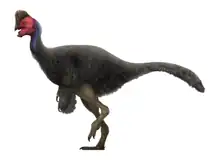 | |
| Ruixinia | 2022 | Yixian Formation (Early Cretaceous, Barremian) | Its last few caudal vertebrae were fused into a rod-like structure | ||
| Ruyangosaurus | 2009 | Haoling Formation (Early Cretaceous, Aptian to Albian) | Only known from scant remains but was one of the largest dinosaurs known from Asia | 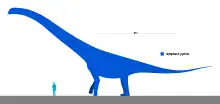 | |
| Sahaliyania | 2008 | Yuliangze Formation (Late Cretaceous, Maastrichtian) | Possibly a synonym of Amurosaurus[115] |  | |
| Saichania | 1977 | Barun Goyot Formation, Nemegt Formation (Late Cretaceous, Campanian to Maastrichtian) | Possessed complicated nasal passages that may have cooled the air it breathed |  | |
| Sanpasaurus | 1944 | Ziliujing Formation (Early Jurassic, Toarcian) | Historically conflated with the remains of an ornithischian |  | |
| Sanxiasaurus | 2019 | Xintiangou Formation (Middle Jurassic, Bajocian) | The oldest neornithischian known from Asia |  | |
| Saurolophus | 1912 | Nemegt Formation (Late Cretaceous, Maastrichtian) | Type species was found in Canada. The Asian species is distinguished by its larger size and backwards-pointing diagonal crest |  | |
| Sauroplites | 1953 | Zhidan Group (Early Cretaceous, Barremian to Aptian) | Preserved lying on its back with parts of its armor in an articulated position | ||
| Saurornithoides | 1924 | Djadochta Formation (Late Cretaceous, Campanian) | Its hindlimbs were well-developed even as juveniles, suggesting it needed little to no parental care |  | |
| Scansoriopteryx | 2002 | Haifanggou Formation (Middle Jurassic to Late Jurassic, Callovian to Kimmeridgian) | Was well-adapted for climbing due to the structure of its hands and feet |  | |
| Segnosaurus | 1979 | Bayan Shireh Formation (Late Cretaceous, Cenomanian to Turonian) | One of the first known therizinosaurs. Its relationships were originally obscure |  | |
| Serikornis | 2017 | Tiaojishan Formation (Middle Jurassic to Late Jurassic, Callovian to Oxfordian) | Possessed simple, wispy feathers similar to those of a Silkie chicken |  | |
| Shamosaurus | 1983 | Dzunbain Formation (Early Cretaceous, Aptian to Albian) | The osteoderms on its head were not separated into obvious tiles as with later ankylosaurs | ||
| Shanag | 2007 | Öösh Formation (Early Cretaceous, Berriasian to Barremian) | Shows a mixture of traits of various paravian groups |  | |
| Shantungosaurus | 1973 | Wangshi Group (Late Cretaceous, Campanian) | The largest known hadrosaurid | 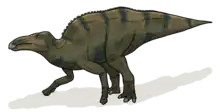 | |
| Shanxia | 1998 | Huiquanpu Formation (Late Cretaceous, Cenomanian to Campanian) | May be synonymous with Tianzhenosaurus[116] and/or Saichania[36] | ||
| Shanyangosaurus | 1996 | Shanyang Formation (Late Cretaceous, Maastrichtian) | Indeterminate but its hollow bones are a synapomorphy for Coelurosauria. One study suggests an oviraptorosaurian position[14] | ||
| Shaochilong | 2009 | Ulansuhai Formation (Late Cretaceous, Cenomanian to Turonian) | Had a relatively short maxilla, suggesting a unique ecological role |  | |
| Shenzhousaurus | 2003 | Yixian Formation (Early Cretaceous, Aptian) | Preserves pebbles in its thoracic cavity which may be gastroliths |  | |
| Shidaisaurus | 2009 | Chuanjie Formation (Middle Jurassic, Aalenian) | Potentially one of the oldest known allosauroids |  | |
| Shishugounykus | 2019 | Shishugou Formation (Late Jurassic, Oxfordian) | Its manus combines features of both alvarezsaurians and more basal coelurosaurs |  | |
| Shixinggia | 2005 | Pingling Formation (Late Cretaceous, Maastrichtian) | Known from a fair amount of postcranial material | ||
| Shri | 2021 | Barun Goyot Formation (Late Cretaceous, Maastrichtian) | Before its formal description, it was nicknamed "Ichabodcraniosaurus" because its holotype lacked a skull |  | |
| Shuangmiaosaurus | 2003 | Sunjiawan Formation (Early Cretaceous, Albian) | Only known from some parts of a skull | ||
| Shunosaurus | 1983 | Shaximiao Formation (Late Jurassic, Oxfordian to Kimmeridgian) | Possessed a small tail club topped by two short spikes |  | |
| Shuvuuia | 1998 | Djadochta Formation (Late Cretaceous, Campanian) | Displays several adaptations that may point to a nocturnal, owl-like lifestyle[117] |  | |
| Siamodon | 2011 | Khok Kruat Formation (Early Cretaceous, Aptian) | May have been closely related to Probactrosaurus[118] |  | |
| Siamosaurus | 1986 | Khok Kruat Formation, Sao Khua Formation (Early Cretaceous, Barremian to Aptian) | Only known from teeth. Some spinosaurid postcrania from the same area may be referrable to this genus[119] |  | |
| Siamotyrannus | 1996 | Sao Khua Formation (Early Cretaceous, Berriasian to Barremian) | Has been recovered in a variety of positions within Avetheropoda | 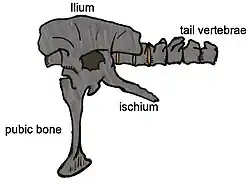 | |
| Siamraptor | 2019 | Khok Kruat Formation (Early Cretaceous, Aptian) | The oldest carcharodontosaurian known from Southeast Asia | .jpg.webp) | |
| Sibirotitan | 2017 | Ilek Formation (Early Cretaceous, Barremian) | Its sacral ribs are star-shaped in dorsal view |  | |
| Siluosaurus | 1997 | Xinminbao Group (Early Cretaceous, Barremian to Albian) | Possessed the smallest known teeth of any ornithopod | ||
| Silutitan | 2021 | Shengjinkou Formation (Early Cretaceous, Aptian) | Known from six cervical vertebrae associated with a pterosaur jaw |  | |
| Similicaudipteryx | 2008 | Jiufotang Formation (Early Cretaceous, Aptian to Albian) | Had a short tail ending with a dagger-shaped pygostyle |  | |
| Sinankylosaurus | 2020 | Wangshi Group (Late Cretaceous, Campanian) | Only known from an ilium. Described as an ankylosaur but a recent study doubts this interpretation[120] | ||
| Sinocalliopteryx | 2007 | Yixian Formation (Early Cretaceous, Barremian to Aptian) | Stomach contents indicate a possible preference for volant prey such as dromaeosaurids and early birds[121] |  | |
| Sinocephale | 2021 | Ulansuhai Formation (Late Cretaceous, Turonian) | Originally named as a species of Troodon when that genus was thought to be a pachycephalosaur | ||
| Sinoceratops | 2010 | Wangshi Group (Late Cretaceous, Campanian to Maastrichtian) | Possessed forward-curving hornlets and a series of low knobs on the top of the frill | 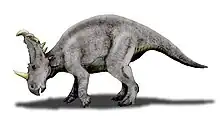 | |
| Sinocoelurus | 1942 | Kuangyuan Series (Late Jurassic, Oxfordian to Tithonian | One study considered it to be a potential plesiosaur[122] |  | |
| Sinornithoides | 1993 | Ejinhoro Formation (Early Cretaceous, Aptian to Albian) | Preserved in a roosting position, its head tucked underneath its left wing |  | |
| Sinornithomimus | 2003 | Ulansuhai Formation (Late Cretaceous, Turonian) | Formed age-segregated herds as evidenced by a concentration of juvenile skeletons[123] |  | |
| Sinornithosaurus | 1999 | Yixian Formation (Early Cretaceous, Barremian to Aptian) | One specimen has disloged teeth, leading to suggestions it was venomous[124] |  | |
| Sinosauropteryx | 1996 | Yixian Formation (Early Cretaceous, Barremian) | The first non-avian dinosaur found with direct evidence of feathers. Analysis of melanosomes suggest it had orange-brown and white countershading with a striped tail and a "bandit mask" around its eyes[125] |  | |
| Sinosaurus | 1940 | Lufeng Formation (Early Jurassic, Hettangian to Sinemurian) | Had a pair of midline crests similar to Dilophosaurus |  | |
| Sinotyrannus | 2009 | Jiufotang Formation (Early Cretaceous, Aptian) | One of the earliest known large tyrannosauroids. Closely related to smaller forms such as Proceratosaurus and Guanlong |  | |
| Sinovenator | 2002 | Yixian Formation (Early Cretaceous, Barremian) | Some specimens are preserved three-dimensionally | .png.webp) | |
| Sinraptor | 1993 | Shishugou Formation (Late Jurassic, Oxfordian) | May have used its teeth like blades to inflict deep wounds in prey |  | |
| Sinusonasus | 2004 | Yixian Formation (Early Cretaceous, Hauterivian) | Had distinctive sinusoid nasal bones |  | |
| Sirindhorna | 2015 | Khok Kruat Formation (Early Cretaceous, Aptian) | Its fossils were discovered by corn farmers while digging a reservoir | 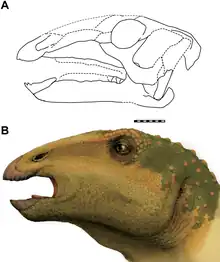 | |
| Sonidosaurus | 2006 | Iren Dabasu Formation (Late Cretaceous, Cenomanian to Campanian) | One of the smallest known titanosaurs |  | |
| Stegosaurides | 1953 | Xinminbao Group (Early Cretaceous, Hauterivian to Albian) | A thyreophoran of uncertain phylogenetic position | ||
| Suzhousaurus | 2007 | Xinminbao Group (Early Cretaceous, Barremian to Aptian) | One of the largest Early Cretaceous therizinosaurs |  | |
| Szechuanosaurus | 1942 | Kuangyuan Series (Late Jurassic, Oxfordian to Tithonian) | Only known from teeth and possibly a very fragmentary skeleton |  | |
| Talarurus | 1952 | Bayan Shireh Formation (Late Cretaceous, Cenomanian to Santonian) | Its tail club has been compared to a wicker basket |  | |
| Tambatitanis | 2014 | Sasayama Group (Early Cretaceous, Albian) | Possessed disproportionately large chevrons | 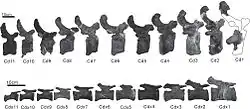 | |
| Tangvayosaurus | 1999 | Grès supérieurs Formation (Early Cretaceous, Aptian to Albian) | Closely related to Phuwiangosaurus |  | |
| Tanius | 1929 | Wangshi Group (Late Cretaceous, Campanian to Maastrichtian) | Today known from only a few bones; more fossils were once present but were not collected |  | |
| Taohelong | 2013 | Hekou Group (Early Cretaceous, Albian) | Possessed a sacral shield similar to that of Polacanthus | ||
| Tarbosaurus | 1955 | Nemegt Formation, Subashi Formation (Late Cretaceous, Maastrichtian) | An apex predator that hunted large prey. Very similar to Tyrannosaurus |  | |
| Tarchia | 1977 | Barun Goyot Formation, Nemegt Formation (Late Cretaceous, Campanian to Maastrichtian) | One specimen preserves injuries to its ribs and tail, possibly from a fight with a member of its own kind[126] |  | |
| Tatisaurus | 1965 | Lufeng Formation (Early Jurassic, Sinemurian) | Potentially a basal thyreophoran |  | |
| Tengrisaurus | 2017 | Murtoi Formation (Early Cretaceous, Barremian to Aptian) | Closely related to South American titanosaurs | ||
| Therizinosaurus | 1954 | Nemegt Formation (Late Cretaceous, Maastrichtian) | Possessed extremely elongated and stiffened hand claws |  | |
| Tianchisaurus | 1993 | Toutunhe Formation (Late Jurassic, Oxfordian to Kimmeridgian) | Its description uses the spellings Tianchisaurus and Tianchiasaurus interchangeably, but the former is correct[127] | ||
| Tianyulong | 2009 | Tiaojishan Formation (Late Jurassic, Oxfordian) | Preserves impressions of long bristles down its back, tail and neck |  | |
| Tianyuraptor | 2009 | Yixian Formation (Early Cretaceous, Barremian to Aptian) | Combines features of both northern and southern dromaeosaurids. Had unusual proportions |  | |
| Tianzhenosaurus | 1998 | Huiquanpu Formation (Late Cretaceous, Cenomanian to Campanian) | May be synonymous with Saichania[36] |  | |
| Tienshanosaurus | 1937 | Shishugou Formation (Late Jurassic, Oxfordian) | Large but basal for a mamenchisaurid[74] |  | |
| Timurlengia | 2016 | Bissekty Formation (Late Cretaceous, Turonian) | Its inner ear was specialized for detecting low-frequency sounds[128] |  | |
| Tochisaurus | 1991 | Nemegt Formation (Late Cretaceous, Maastrichtian) | Known from only a single metatarsus |  | |
| Tonganosaurus | 2010 | Yimen Formation (Early Jurassic, Pliensbachian) | Potentially the oldest known mamenchisaurid | ||
| Tongtianlong | 2016 | Nanxiong Formation (Late Cretaceous, Maastrichtian) | The pose of the holotype suggests it died while trying to free itself from mud | 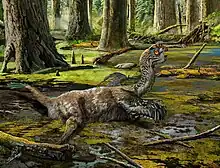 | |
| Tsaagan | 2006 | Djadochta Formation (Late Cretaceous, Campanian) | Very similar to Velociraptor but differs in some features of the skull[129] |  | |
| Tsagantegia | 1993 | Bayan Shireh Formation (Late Cretaceous, Cenomanian to Santonian) | Had a long, shovel-shaped snout which may indicate a browsing lifestyle[130] |  | |
| Tsintaosaurus | 1958 | Wangshi Group (Late Cretaceous, Campanian) | Originally mistakenly believed to have possessed a unicorn horn-like crest |  | |
| Tugulusaurus | 1973 | Lianmuqin Formation (Early Cretaceous, Barremian to Albian) | Potentially an early, Xiyunykus-grade alvarezsaurian[131] | ||
| Tuojiangosaurus | 1977 | Shaximiao Formation (Late Jurassic, Oxfordian to Kimmeridgian) | Possessed two rows of tall, pointed plates, thickened in the center as if they were modified spikes |  | |
| Turanoceratops | 1989 | Bissekty Formation (Late Cretaceous, Turonian) | Had a pair of brow horns like ceratopsids but was likely not a member of that family |  | |
| Tylocephale | 1974 | Barun Goyot Formation (Late Cretaceous, Campanian) | Only known from a partial skull but it is enough to tell that it had a remarkably tall dome |  | |
| Tyrannomimus | 2023 | Kitadani Formation (Early Cretaceous, Aptian) | Its ilium is remarkably similar to that of the supposed tyrannosauroid Aviatyrannis |  | |
| Udanoceratops | 1992 | Djadochta Formation (Late Cretaceous, Campanian) | The largest known leptoceratopsid |  | |
| Ultrasaurus | 1983 | Gugyedong Formation (Early Cretaceous, Aptian to Albian) | Described as very large but this may be due to misidentification of a bone | ||
| Ulughbegsaurus | 2021 | Bissekty Formation (Late Cretaceous, Turonian) | Known from only a maxilla. Originally described as a late-surviving carnosaur but may in fact be a large-bodied dromaeosaurid[132] | ||
| Urbacodon | 2007 | Bissekty Formation, Dzharakuduk Formation (Late Cretaceous, Cenomanian to Turonian) | The holotype preserves a gap separating the eight rear teeth from the rest of its teeth | ||
| Vayuraptor | 2019 | Sao Khua Formation (Early Cretaceous, Barremian) | Potentially ancestral to megaraptorans[133] or an early member of the group[134] | ||
| Velociraptor | 1924 | Bayan Mandahu Formation, Djadochta Formation (Late Cretaceous, Campanian) | One potential specimen preserves quill knobs[135] |  | |
| Wakinosaurus | 1992 | Sengoku Formation (Early Cretaceous, Valanginian to Barremian) | May be a close relative of Acrocanthosaurus[109] | ||
| Wannanosaurus | 1977 | Xiaoyan Formation (Late Cretaceous, Maastrichtian) | Basal for a pachycephalosaur as indicated by its flat skull with large openings |  | |
| Wuerhosaurus | 1973 | Ejinhoro Formation, Tugulu Group (Early Cretaceous, Hauterivian) | One of the last and largest known stegosaurs. Preserved with low rectangular plates but these may be broken |  | |
| Wulagasaurus | 2008 | Yuliangze Formation (Late Cretaceous, Maastrichtian) | A rare hadrosaurid known from far less remains than the contemporary Sahaliyania |  | |
| Wulatelong | 2013 | Bayan Mandahu Formation (Late Cretaceous, Campanian) | Known from a partial skeleton including some parts of the skull |  | |
| Wulong | 2020 | Jiufotang Formation (Early Cretaceous, Aptian) | Analysis of preserved melanosomes suggests it was mostly gray with iridescent wings[136] |  | |
| Xianshanosaurus | 2009 | Haoling Formation (Early Cretaceous, Aptian to Albian) | May have been closely related to Daxiatitan[90] | 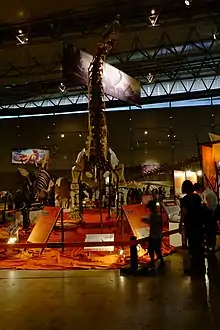 | |
| Xiaosaurus | 1983 | Shaximiao Formation (Middle Jurassic, Bajocian to Callovian) | An ornithischian of uncertain affinities | ||
| Xiaotingia | 2011 | Tiaojishan Formation (Middle Jurassic to Late Jurassic, Bathonian to Oxfordian) | Well-preserved but inconsistent in phylogenetic placement. Some studies suggest a position as an early avialan[137] |  | |
| Xingtianosaurus | 2019 | Yixian Formation (Early Cretaceous, Barremian) | Retained the large third finger that was lost in other caudipterids |  | |
| Xingxiulong | 2017 | Lufeng Formation (Early Jurassic, Hettangian) | Possessed a robust scapula which increased forelimb mobility for feeding |  | |
| Xinjiangovenator | 2005 | Lianmuqin Formation (Early Cretaceous, Valanginian to Albian) | Remains originally identified as Phaedrolosaurus |  | |
| Xinjiangtitan | 2013 | Qiketai Formation (Middle Jurassic, Callovian) | Had an extremely long neck | .jpg.webp) | |
| Xiongguanlong | 2009 | Xinminbao Group, (Early Cretaceous, Aptian) | More robust than other early tyrannosauroids, possibly to support its elongated skull |  | |
| Xixianykus | 2010 | Majiacun Formation (Late Cretaceous, Santonian to Coniacian) | One of the smallest known non-avian dinosaurs |  | |
| Xixiasaurus | 2010 | Majiacun Formation (Late Cretaceous, Coniacian to Campanian) | Distinguished from other troodontids by its possession of exactly twenty-two teeth in each maxilla |  | |
| Xixiposaurus | 2010 | Lufeng Formation (Early Jurassic, Hettangian to Toarcian) | Poorly known | ||
| Xiyunykus | 2018 | Tugulu Group (Early Cretaceous, Barremian to Aptian) | Had an unspecialized hand morphology for an alvarezsaur, having three fingers of roughly equal length and construction | 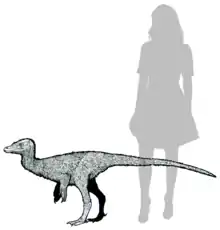 | |
| Xuanhanosaurus | 1984 | Shaximiao Formation (Middle Jurassic to Late Jurassic, Bathonian) | Originally mistakenly believed to have been capable of quadrupedal locomotion |  | |
| Xuanhuaceratops | 2006 | Houcheng Formation (Late Jurassic, Tithonian) | Possessed a large premaxillary tooth right behind its beak |  | |
| Xunmenglong | 2019 | Huajiying Formation (Early Cretaceous, Hauterivian) | The holotype was originally presented as part of a chimera involving three different animals[138] |  | |
| Xuwulong | 2011 | Xinminbao Group (Early Cretaceous, Aptian to Albian) | The tip of its dentary was V-shaped when viewed from the side |  | |
| Yamaceratops | 2006 | Javkhlant Formation (Late Cretaceous, Santonian) | Possessed a short, stubby frill |  | |
| Yamatosaurus | 2021 | Kita-Ama Formation (Late Cretaceous, Maastrichtian) | Basal yet survived late enough to be contemporaneous with more advanced hadrosaurids |  | |
| Yandusaurus | 1979 | Shaximiao Formation (Middle Jurassic, Bathonian) | Some fossils were destroyed by a composter before they could be studied[139] |  | |
| Yangchuanosaurus | 1978 | Shaximiao Formation (Middle Jurassic to Late Jurassic, Bathonian to Oxfordian) | The largest theropod known from the Shaximiao |  | |
| Yi | 2015 | Tiaojishan Formation (Middle Jurassic to Late Jurassic, Callovian to Oxfordian) | Possessed a "styliform element" jutting out from its wrist that supported a bat-like membranous wing |  | |
| Yimenosaurus | 1990 | Fengjiahe Formation (Early Jurassic, Pliensbachian) | Much of its skeleton is known, including the entirety of the skull |  | |
| Yingshanosaurus | 1994 | Shaximiao Formation (Late Jurassic, Kimmeridgian) | Possessed greatly enlarged shoulder spines |  | |
| Yinlong | 2006 | Shishugou Formation (Late Jurassic, Oxfordian) | Its skull displays features of ceratopsians, pachycephalosaurs, and heterodontosaurids |  | |
| Yixianosaurus | 2003 | Yixian Formation (Early Cretaceous, Aptian) | Inconsistent in phylogenetic placement. Had extremely elongated manual elements |  | |
| Yizhousaurus | 2018 | Lufeng Formation (Early Jurassic, Sinemurian) | Its skull was very similar to those of sauropods, despite being more primitive |  | |
| Yongjinglong | 2014 | Hekou Group (Early Cretaceous, Albian) | Possessed an extremely long, broad scapula |  | |
| Yuanmousaurus | 2006 | Zhanghe Formation (Middle Jurassic, Aalenian to Callovian) | Shares features of its vertebrae with Patagosaurus |  | |
| Yueosaurus | 2012 | Liangtoutang Formation (Early Cretaceous to Late Cretaceous, Albian to Cenomanian) | Probably closely related to Jeholosaurus[140] |  | |
| Yulong | 2013 | Qiupa Formation (Late Cretaceous, Maastrichtian) | Known from multiple specimens, most of which are juveniles |  | |
| Yunganglong | 2013 | Zhumapu Formation (Late Cretaceous, Cenomanian) | Discovered 50 kilometres (31 mi) away from a World Heritage Site |  | |
| Yunmenglong | 2013 | Haoling Formation (Early Cretaceous, Barremian to Albian) | May have been exceptionally large | ||
| Yunnanosaurus | 1942 | Fengjiahe Formation, Lufeng Formation (Early Jurassic, Sinemurian to Pliensbachian) | Its teeth were self-sharpening similar to those of sauropods, likely through convergent evolution[141] |  | |
| Yunyangosaurus | 2020 | Xintiangou Formation (Middle Jurassic to Late Jurassic, Aalenian to Oxfordian) | Potentially an early megalosauroid | ||
| Yutyrannus | 2012 | Yixian Formation (Early Cretaceous, Aptian) | The largest known dinosaur that preserves direct evidence of feathers |  | |
| Yuxisaurus | 2022 | Fengjiahe Formation (Early Jurassic, Sinemurian to Toarcian) | Had more than one hundred osteoderms |  | |
| Yuzhoulong | 2022 | Shaximiao Formation (Middle Jurassic, Bathonian) | One of the oldest known macronarians |  | |
| Zanabazar | 2009 | Nemegt Formation (Late Cretaceous, Maastrichtian) | Originally named as a species of Saurornithoides. A large troodontid |  | |
| Zaraapelta | 2014 | Barun Goyot Formation (Late Cretaceous, Campanian to Maastrichtian) | Had an intricate pattern of osteoderms on its skull | ||
| Zhanghenglong | 2014 | Majiacun Formation (Late Cretaceous, Santonian) | Reconstructed by its describers with a straight, rectangular back, although no complete neural spines are known[142] | -with-Transitional-Features-from-the-Late-pone.0098821.g002.jpg.webp) | |
| Zhejiangosaurus | 2007 | Chaochuan Formation (Late Cretaceous, Cenomanian) | Has no diagnostic features[36] | _(16411826393).jpg.webp) | |
| Zhenyuanlong | 2015 | Yixian Formation (Early Cretaceous, Aptian) | Possessed large wings with long feathers, but was most likely flightless |  | |
| Zhongjianosaurus | 2017 | Yixian Formation (Early Cretaceous, Barremian to Aptian) | Distinguishable by its characteristically elongated legs. Described as a microraptorian[143] but it has been noted that some features of its skeleton are similar to avialans[39] |  | |
| Zhuchengceratops | 2010 | Wangshi Group (Late Cretaceous, Maastrichtian) | Had a particularly deep mandible |  | |
| Zhuchengtitan | 2017 | Wangshi Group (Late Cretaceous, Campanian) | The proportions of its humerus suggest a close relationship with Opisthocoelicaudia[144] |  | |
| Zhuchengtyrannus | 2011 | Wangshi Group (Late Cretaceous, Campanian) | Closely related to Tarbosaurus and Tyrannosaurus |  | |
| Zigongosaurus | 1976 | Shaximiao Formation (Middle Jurassic to Late Jurassic, Bathonian to Tithonian) | May be a species of Mamenchisaurus[145] | ||
| Zizhongosaurus | 1983 | Ziliujing Formation (Early Jurassic, Toarcian) | Poorly known but was most likely basal for a sauropod | ||
| Zuolong | 2010 | Shishugou Formation (Late Jurassic, Oxfordian | Known from both cranial and postcranial remains |  | |
| Zuoyunlong | 2017 | Zhumapu Formation (Late Cretaceous, Cenomanian) | May have been close to the separation between North American and Asian hadrosauroids[146] |  |
Invalid and potentially valid genera
- Amtosaurus magnus: An indeterminate ornithischian that may be either a hadrosaurid or an ankylosaurid.
- Antarctosaurus: A. jaxarticus from Kazakhstan has been referred to this genus, but such an assignment is probably incorrect.
- Asiamericana asiatica: Known only from teeth, it has been suggested to a fish, a spinosaurid, or a species of Richardoestesia.
- "Bakesaurus": Often included in lists of dinosaurs as a nomen nudum, but may simply be a junior synonym or misspelling of Bactrosaurus
- "Balochisaurus malkani": A supposed saltasaurid titanosaur from Pakistan. A paper published in 2021 could make this, as well as other informal Pakistani dinosaurs, valid.
- Beipiaognathus jii: Described based on a chimeric holotype including compsognathid elements.
- "Changdusaurus laminoplacodus": A potential stegosaur; its remains are now thought to be lost.
- Chienkosaurus ceratosauroides: A possible junior synonym of Szechuanosaurus.
- "Dachongosaurus yunnanensis": Reportedly a Cetiosaurus-like sauropod.
- "Damalasaurus". An indeterminate sauropod. Two species have been named, albeit informally.
- "EK troodontid": The informal name for specimen SPS 100/44, a troodontid discovered in Early Cretaceous sediments from Mongolia.
- Epidendrosaurus ninchengensis: Generally agreed to be the same taxon as Scansoriopteryx. There is debate as to which name has priority; different researchers use either name to refer to the same animal.
- "Eugongbusaurus" wucaiwanensis: Coined for a referred species of Gongbusaurus. This name is said to have been leaked accidentally.
- "Futabasaurus": A supposed tyrannosaur from Japan. If formally described, it would require a new name as Futabasaurus has already been used for a plesiosaur.
- "Gadolosaurus": The name is an incorrect romanization of the Russian word gadrosavr, meaning hadrosaur, and was not meant to be a new generic name. It may have been a synonym of Arstanosaurus.
- Gobiceratops minutus: May be a growth stage of Bagaceratops.
- "Gspsaurus pakistani": One of several informally-named titanosaurs from Pakistan.
- Gyposaurus: Type species was found in South Africa and may be a synonym of Massospondylus. The Asian species may be identical to Lufengosaurus.
- "Hanwulosaurus": Possibly the most complete ankylosaur known from Asia. Said to belong to its own subgroup within the Ankylosauria.
- "Heilongjiangosaurus jiayinensis": May be a synonym of Charonosaurus and/or "Mandschurosaurus" jiayinensis.
- "Khetranisaurus barkhani": Also spelled "Khateranisaurus". Both spellings remain informal.
- "Koreanosaurus": No relationship to the formally-named ornithischian of the same name (see above). Later renamed "Deinonychus" "koreanensis", but this generic assignment is likely incorrect.
- "Kunmingosaurus wudingensis": Although sometimes presented as a valid taxon, it is in fact a nomen nudum.
- Lamaceratops tereschenkoi: May be a junior synonym of Bagaceratops.
- "Lancanjiangosaurus cachuensis": An informally-named sauropod. Has also been spelled "Lancangosaurus".
- Lukousaurus yini: Sometimes thought to be either a theropod or a pseudosuchian.
- Magnirostris dodsoni: Supposedly distinguishable from other basal ceratopsians by its incipient horn cores, but it may actually be a Bagaceratops with a preservation artifact.
- "Marisaurus jeffi": Potentially closely related to "Balochisaurus" and "Sulaimanisaurus".
- "Megacervixosaurus tibetensis": A sauropod. Its classification is uncertain, but it may be a titanosaur.
- "Microdontosaurus dayensis": May have been formally described a different name, but it cannot be proven.
- "Ngexisaurus dapukaensis": Sometimes known as Megalosaurus "dapukaensis", but it is unlikely to belong to this genus.
- Nomingia gobiensis: Notable as one of the first non-avian dinosaurs found with a pygostyle. It may, however, be a synonym of Elmisaurus.
- "Nurosaurus qaganensis": Noteworthy for preserving the first stress fracture found on a sauropod foot. Presented as "soon to be described" in 1992 but remains a nomen nudum to this day.
- "Oshanosaurus youngi": An early sauropod. Has been confused with heterodontosaurids and Eshanosaurus.
- "Otogosaurus sarulai". Very little is known about it. Although it often appears on lists of dinosaurs as a valid taxon, there is no proof it was ever validly named.
- "Pakisaurus balochistani": A titanosaur. It has been referred to the similarly informal titanosaurian family "Pakisauridae".
- Platyceratops tatarinovi: May be a junior synonym of Bagaceratops.
- Raptorex kriegsteini: Described as a small adult tyrannosaur from the Early Cretaceous of China. However, restudy of the sediments it was buried in suggested it was from the Late Cretaceous of Mongolia, and thus more likely a juvenile Tarbosaurus.
- "Ronaldoraptor": An oviraptorosaur with a tall, rectangular crest. Named in a book described as a field guide for time travelers.
- "Sanchusaurus": Said to be potentially synonymous with Gallimimus.
- "Sangonghesaurus": Possibly a synonym of Tianchisaurus, if it is not a basal ornithischian.
- Shuangbaisaurus anlongbaoensis: May be an individual variation of Sinosaurus.
- "Sinopliosaurus" fusuiensis: Originally thought to be a plesiosaur but is actually a spinosaurid. It may be synonymous with Siamosaurus.
- "Sugiyamasaurus": Known only from teeth that may belong to Fukuititan.
- "Sulaimanisaurus gingerichi": An informally-named Pakistani titanosaur.
- "Szechuanoraptor dongi": Coined for a referred specimen of Szechuanosaurus. It may belong to Yangchuanosaurus zigongensis.
- "Tonouchisaurus mongoliensis": A theropod reported to have a completely didactyl manus.
- "Vitakridrinda sulaimani": Supposedly an abelisaurid. It is sometimes treated as valid in mainstream literature, such as in a book by Thomas Holtz.
- "Vitakrisaurus saraiki": A noasaurid from the same layers as "Vitakridrinda".
- "Yibinosaurus zhoui": May in fact be a second species of Gongxianosaurus.
- "Yunxianosaurus hubeinensis": Mentioned in a scientific paper as a temporary placeholder name. Further work is needed to determine whether it deserves a formal name.
- Zhongornis haoae: Known from a juvenile skeleton. It is usually thought to be a basal avialan but one hypothesis is that it is a non-avian scansoriopterygid.
- Zhongyuansaurus luoyangensis: Potentially a synonym of Gobisaurus.
Timeline
This is a timeline of selected dinosaurs from the list above. Time is measured in Ma, megaannum, along the x-axis.

See also
References
- ↑ Alexander Averianov; Alexey Lopatin (2020). "An unusual new sauropod dinosaur from the Late Cretaceous of Mongolia". Journal of Systematic Palaeontology. 18 (12): 1009–1032. doi:10.1080/14772019.2020.1716402.
- ↑ Scott Persons IV, W.; Currie, P. J. (2016). "An approach to scoring cursorial limb proportions in carnivorous dinosaurs and an attempt to account for allometry". Scientific Reports. 6 (19828): 19828. Bibcode:2016NatSR...619828P. doi:10.1038/srep19828. PMC 4728391. PMID 26813782.
- ↑ Carr, T. D.; Williamson, T. E. (2005). "A reappraisal of tyrannosauroids from Iren Dabasu, Inner Mongolia, People's Republic of China". Journal of Vertebrate Paleontology. 25 (3).
- 1 2 Pei, R.; Norell, M.A.; Barta, D.E.; Bever, G.S.; Pittman, M.; Xu, Xing (2017). "Osteology of a New Late Cretaceous Troodontid Specimen from Ukhaa Tolgod, Ömnögovi Aimag, Mongolia". American Museum Novitates (3889): 1–47. doi:10.1206/3889.1. S2CID 90883541.
- ↑ Bertozzo F, Bolotsky I, Bolotsky YL, Poberezhskiy A, Ruffell A, Godefroit P, Murphy E (2023). "A pathological ulna of Amurosaurus riabinini from the Upper Cretaceous of Far Eastern Russia". Historical Biology: An International Journal of Paleobiology. 35 (2): 268–275. doi:10.1080/08912963.2022.2034805. S2CID 247003496.
- ↑ Li, Q.; Gao, K.-Q.; Vinther, J.; Shawkey, M. D.; Clarke, J. A.; d'Alba, L.; Meng, Q.; Briggs, D. E. G.; Prum, R. O. (2010). "Plumage color patterns of an extinct dinosaur" (PDF). Science. 327 (5971): 1369–1372. Bibcode:2010Sci...327.1369L. doi:10.1126/science.1186290. PMID 20133521. S2CID 206525132.
- ↑ Yilun Yu; Kebai Wang; Shuqing Chen; Corwin Sullivan; Shuo Wang; Peiye Wang; Xing Xu (2018). "A new caenagnathid dinosaur from the Upper Cretaceous Wangshi Group of Shandong, China, with comments on size variation among oviraptorosaurs". Scientific Reports. 8 (1): Article number 5030. Bibcode:2018NatSR...8.5030Y. doi:10.1038/s41598-018-23252-2. PMC 5864915. PMID 29567954.
- ↑ Xing Xu; Jonah Choiniere; Qingwei Tan; Roger B.J. Benson; James Clark; Corwin Sullivan; Qi Zhao; Fenglu Han; Qingyu Ma; Yiming He; Shuo Wang; Hai Xing; Lin Tan (2018). "Two Early Cretaceous fossils document transitional stages in alvarezsaurian dinosaur evolution". Current Biology. Online edition. doi:10.1016/j.cub.2018.07.057.
- ↑ Elżanowski, Andrzej; Wellnhofer, Peter (1993). "Skull of Archaeornithoides from the Upper Cretaceous of Mongolia" (PDF). American Journal of Science. 293: 235–252. Bibcode:1993AmJS..293..235E. doi:10.2475/ajs.293.A.235.
- ↑ Godefroit, P.; Bolotsky, Y.L. & Bolotsky, I.Y. (2011). "Osteology and relationships of Olorotitan arharensis, a hollowcrested hadrosaurid dinosaur from the latest Cretaceous of Far Eastern Russia". Acta Palaeontologica Polonica. 57 (3): 527. doi:10.4202/app.2011.0051.
- ↑ Yiming He; Peter J. Makovicky; Kebai Wang; Shuqing Chen; Corwin Sullivan; Fenglu Han; Xing XuMichael J. Ryan; David C. Evans; Philip J. Currie; Caleb M. Brown; Don Brinkman (2015). "A New Leptoceratopsid (Ornithischia, Ceratopsia) with a Unique Ischium from the Upper Cretaceous of Shandong Province, China". PLOS ONE. 10 (12): e0144148. Bibcode:2015PLoSO..1044148H. doi:10.1371/journal.pone.0144148. PMC 4689537. PMID 26701114.
- ↑ Funston, G.F.; Currie, P.J.; Eberth, D.A.; Ryan, M.J.; Chinzorig, T.; Badamgarav, D.; Longrich, N.R. (2016). "The first oviraptorosaur (Dinosauria: Theropoda) bonebed: evidence of gregarious behaviour in a maniraptoran theropod". Scientific Reports. 6: 35782. Bibcode:2016NatSR...635782F. doi:10.1038/srep35782. PMC 5073311. PMID 27767062.
- ↑ Czepiński, Ł. (2019). "Ontogeny and variation of a protoceratopsid dinosaur Bagaceratops rozhdestvenskyi from the Late Cretaceous of the Gobi Desert" (PDF). Historical Biology. 32 (10): 1394–1421. doi:10.1080/08912963.2019.1593404. S2CID 132780322. Archived from the original (PDF) on 8 July 2021. Retrieved 11 January 2022.
- 1 2 3 4 5 Hartman, S.; Mortimer, M.; Wahl, W. R.; Lomax, D. R.; Lippincott, J.; Lovelace, D. M. (2019). "A new paravian dinosaur from the Late Jurassic of North America supports a late acquisition of avian flight". PeerJ. 7: e7247. doi:10.7717/peerj.7247. PMC 6626525. PMID 31333906.
- ↑ Makovicky, Peter J.; Norell, Mark A. (2006). "Yamaceratops dorngobiensis, a new primitive ceratopsian (Dinosauria: Ornithischia) from the Cretaceous of Mongolia" (PDF). American Museum Novitates (3530): 1–42. doi:10.1206/0003-0082(2006)3530[1:YDANPC]2.0.CO;2. Archived from the original (PDF) on 25 July 2008. Retrieved 11 January 2022.
- ↑ Dai H, Tan C, Xiong C, Ma Q, Li N, Yu H, Wei Z, Wang P, Yi J, Wei G, You H, Ren X (2022). "New macronarian from the Middle Jurassic of Chongqing, China: phylogenetic and biogeographic implications for neosauropod dinosaur evolution". Royal Society Open Science. 9 (11). 220794. Bibcode:2022RSOS....920794D. doi:10.1098/rsos.220794. PMC 9627447. PMID 36340515.
- ↑ Pu, H.; Zelenitsky, D.K.; Lü, J.; Currie, P.J.; Carpenter, K.; Xu, L.; Koppelhus, E.B.; Jia, S.; Xiao, L.; Chuang, H.; Li, T.; Kundrát, M.; Shen, C. (2017). "Perinate and eggs of a giant caenagnathid dinosaur from the Late Cretaceous of central China". Nature Communications. 8: 14952. Bibcode:2017NatCo...814952P. doi:10.1038/ncomms14952. PMC 5477524. PMID 28486442.
- ↑ Xu, X.; Zheng, X.; You, H. (2009). "A new feather type in a nonavian theropod and the early evolution of feathers". Proceedings of the National Academy of Sciences. 106 (3): 832–834. doi:10.1073/pnas.0810055106. PMC 2630069. PMID 19139401.
- ↑ Raven, T.J., Barrett, P.M., Xu, X., and Maidment, S.C.R. 2019. "A reassessment of the purported ankylosaurian dinosaur Bienosaurus lufengensis from the Lower Lufeng Formation of Yunnan, China". Acta Palaeontologica Polonica 64
- ↑ Alifanov, V. R.; Saveliev, S. V. (2019). "The Brain Morphology and Neurobiology in Armored Dinosaur Bissekipelta archibaldi (Ankylosauridae) from the Late Cretaceous of Uzbekistan". Paleontological Journal. 53 (3): 315–321. doi:10.1134/S003103011903002X. ISSN 0031-0301. S2CID 195299630.
- ↑ Zheng; Wenjie; Jin; Xingsheng; Shibata; Masteru; Azuma & Yoichi (2013). "An early juvenile specimen of Bolong yixianensis (Ornithopoda:Iguanodontia) from the Lower Cretaceous of Ningcheng County, Nei Mongol, China". Historical Biology. 26 (2): 236–251. doi:10.1080/08912963.2013.809347. S2CID 129081459.
- ↑ Grellet-Tinner, G. (2005). "Chapter VII – An Egg Clutch of the Troodontid Byronosaurus jaffei from the Gobi Desert: Novel Perspectives on the Origin of the Avian Reproductive Physiology". A Phylogenetic Analysis of Oological Characters: A Case Study of Saurischian Dinosaur Relationships and Avian Evolution. pp. 105–117.
- ↑ Alifanova, V. R.; Barsboldb, R. (2009). "Ceratonykus oculatus gen. et sp. nov., a New Dinosaur (?Theropoda, Alvarezsauria) from the Late Cretaceous of Mongolia". Paleontological Journal. 43 (1): 94–106. doi:10.1134/S0031030109010109. S2CID 129589208.
- ↑ Jun Chen, Aaron R. H. LeBlanc, Liyong Jin, Timothy Huang, Robert R. Reisz. Tooth development, histology, and enamel microstructure in Changchunsaurus parvus: Implications for dental evolution in ornithopod dinosaurs. PLOS ONE, 2018; 13 (11): e0205206 DOI: 10.1371/journal.pone.0205206
- ↑ Gang Han; Luis M. Chiappe; Shu-An Ji; Michael Habib; Alan H. Turner; Anusuya Chinsamy; Xueling Liu & Lizhuo Han (15 July 2014). "A new raptorial dinosaur with exceptionally long feathering provides insights into dromaeosaurid flight performance". Nature Communications. 5: 4382. Bibcode:2014NatCo...5.4382H. doi:10.1038/ncomms5382. PMID 25025742.
- ↑ Barrett, Paul M.; Yoshikazu Hasegawa; Makoto Manabe; Shinji Isaji; Hiroshige Matsuoka (2002). "Sauropod dinosaurs from the Lower Cretaceous of eastern Asia: taxonomic and biogeographical implications". Palaeontology. 45 (6): 1197–1217. Bibcode:2002Palgy..45.1197B. doi:10.1111/1475-4983.00282.
- ↑ Russell, Dale A.; Z. Zheng (1993). "A large mamenchisaurid from the Junggar Basin, Xinjiang, People's Republic of China". Canadian Journal of Earth Sciences. 30 (10–11): 2082–2095. Bibcode:1993CaJES..30.2082R. doi:10.1139/e93-180.
- ↑ Brusatte, S. L., Hone, D. W. E., and Xu, X. 2013. "Phylogenetic revision of Chingkankousaurus fragilis, a forgotten tyrannosauroid specimen from the Late Cretaceous of China." In: J.M. Parrish, R.E. Molnar, P.J. Currie, and E.B. Koppelhus (eds.), Tyrannosaur! Studies in Tyrannosaurid Paleobiology. Indiana University Press, Bloomington, IN.
- ↑ Terry A. Gates; Khishigjav Tsogtbaatar; Lindsay E. Zanno; Tsogtbaatar Chinzorig; Mahito Watabe (2018). "A new iguanodontian (Dinosauria: Ornithopoda) from the Early Cretaceous of Mongolia". PeerJ. 6: e5300. doi:10.7717/peerj.5300. PMC 6078070. PMID 30083450.
- ↑ Xin-Xin Ren; Toru Sekiya; Tao Wang; Zhi-Wen Yang; Hai-Lu You (2020). "A revision of the referred specimen of Chuanjiesaurus anaensis Fang et al., 2000: a new early branching mamenchisaurid sauropod from the Middle Jurassic of China". Historical Biology: An International Journal of Paleobiology. 33 (9): 1872–1887. doi:10.1080/08912963.2020.1747450. S2CID 216283529.
- ↑ Xiaobo, Li; Reisz, Robert R. (2019). The early Cretaceous ankylosaur Liaoningosaurus from Western Liaoning, China: Progress and problems. 7th Annual Meeting Canadian Society of Vertebrate Palaeontology, 10–13 May 2019. Grande Prairie, Alberta, Canada. pp. 31–32. doi:10.18435/vamp29349.
- ↑ Qian‐Nan Zhang; Tao Wang; Zhi‐Wen Yang; Hai‐Lu You (2019). "Redescription of the cranium of Jingshanosaurus xinwaensis (Dinosauria: Sauropodomorpha) from the Lower Jurassic Lufeng Formation of Yunnan Province, China". The Anatomical Record. 303 (4): 759–771. doi:10.1002/ar.24113. PMID 30860663. S2CID 75140305.
- ↑ Funston, G. F.; Tsogtbaatar, C.; Tsogtbaatar, K.; Kobayashi, Y.; Sullivan, C.; Currie, P. J. (2020). "A new two-fingered dinosaur sheds light on the radiation of Oviraptorosauria". Royal Society Open Science. 7 (10): 201184. Bibcode:2020RSOS....701184F. doi:10.1098/rsos.201184. PMC 7657903. PMID 33204472.
- ↑ Ren XX, Jiang S, Wang XR, Peng GZ, Ye Y, Jia L, You HL (2022). "Re-examination of Dashanpusaurus dongi (Sauropoda: Macronaria) supports an early Middle Jurassic global distribution of neosauropod dinosaurs". Palaeogeography, Palaeoclimatology, Palaeoecology. 610. 111318. doi:10.1016/j.palaeo.2022.111318.
- ↑ Xing L., Bell, P.R., Currie, P.J., Shibata M., Tseng K. & Dong Z. (2012). "A sauropod rib with an embedded theropod tooth: direct evidence for feeding behaviour in the Jehol group, China." Lethaia, (advance online publication). doi:10.1111/j.1502-3931.2012.00310.x.
- 1 2 3 4 5 Arbour, Victoria M.; Currie, Philip J. (2015). "Systematics, phylogeny and palaeobiogeography of the ankylosaurid dinosaurs". Journal of Systematic Palaeontology. 14 (5): 385–444. doi:10.1080/14772019.2015.1059985. S2CID 214625754.
- ↑ Averianov, A.; Sues, H.-D. (2021). "First rebbachisaurid sauropod dinosaur from Asia". PLOS ONE. 16 (2): e0246620. Bibcode:2021PLoSO..1646620A. doi:10.1371/journal.pone.0246620. PMC 7904184. PMID 33626060.
- ↑ Lerzo, Lucas; Carballido, José; Gallina, Pablo (2022). "e Cretaceous ofUzbekistan". Publicación Electrónica de la Asociación Paleontológica Argentina. 21 (1): 18–27. doi:10.5710/PEAPA.24.03.2021.389. hdl:11336/165212.
- 1 2 Agnolin, Federico L.; Motta, Matias J.; Brissón Egli, Federico; Lo Coco, Gastón; Novas, Fernando E. (2019). "Paravian Phylogeny and the Dinosaur-Bird Transition: An Overview". Frontiers in Earth Science. 6: 252. Bibcode:2018FrEaS...6..252A. doi:10.3389/feart.2018.00252. hdl:11336/130197. ISSN 2296-6463.
- ↑ Yan Wu; Hai-Lu You; Xiao-Qiang Li (2018). "Dinosaur-associated Poaceae epidermis and phytoliths from the Early Cretaceous of China". National Science Review. 5 (5): 721–727. doi:10.1093/nsr/nwx145.
- ↑ Nesov, L.A., 1995, "Dinozavri severnoi Yevrasii: Novye dannye o sostave kompleksov, ekologii i paleobiogeografii", Scientific Research Institute of the Earth's Crust, St. Petersburg State University, St. Petersburg, Russia: pp 156
- 1 2 Paul, G.S., 2010, The Princeton Field Guide to Dinosaurs, Princeton University Press
- ↑ Kobayashi, Y. and Azuma, Y. (2003). "A new iguanodontian (Dinosauria; Ornithopoda), form the lower Cretaceous Kitadani Formation of Fukui Prefecture, Japan". Journal of Vertebrate Paleontology 23(1): 166–175
- ↑ Hattori, S.; Kawabe, S.; Imai, T.; Shibata, M.; Miyata, K.; Xu, X.; Azuma, Y. (2021). "OSTEOLOGY OF FUKUIVENATOR PARADOXUS: A BIZARRE MANIRAPTORAN THEROPOD FROM THE EARLY CRETACEOUS OF FUKUI, JAPAN" (PDF). Memoir of the Fukui Prefectural Dinosaur Museum. 20: 1–82.
- ↑ Jinyou Mo, Jincheng Li, Yunchuan Ling, Eric Buffetaut, Suravech Suteethorn Varavud, Suteethorne Haiyan Tong, Gilles Cuny, Romain Amiot & Xing Xu (2020). New fossil remain of Fusuisaurus zhaoi (Sauropoda: Titanosauriformes) from the Lower Cretaceous of Guangxi, southern China. Cretaceous Research: 104379 (advance online publication). doi: https://doi.org/10.1016/j.cretres.2020.104379
- ↑ Lü, J.; Yi, L.; Zhong, H.; Wei, X. (2013). Dodson, Peter (ed.). "A New Oviraptorosaur (Dinosauria: Oviraptorosauria) from the Late Cretaceous of Southern China and Its Paleoecological Implications". PLOS ONE. 8 (11): e80557. Bibcode:2013PLoSO...880557L. doi:10.1371/journal.pone.0080557. PMC 3842309. PMID 24312233.
- ↑ Rothschild, B. M.; Tanke, D. H.; Helbling II, M.; Martin, L. D. (2003). "Epidemiologic study of tumors in dinosaurs" (PDF). Naturwissenschaften. 90 (11): 495–500. Bibcode:2003NW.....90..495R. doi:10.1007/s00114-003-0473-9. PMID 14610645. S2CID 13247222.
- ↑ Lee, Sungjin; Lee, Yuong-Nam; Chinsamy, Anusuya; Lü, Junchang; Barsbold, Rinchen; Tsogtbaatar, Khishigjav (2019). "A new baby oviraptorid dinosaur (Dinosauria: Theropoda) from the Upper Cretaceous Nemegt Formation of Mongolia". PLOS ONE. 14 (2): e0210867. Bibcode:2019PLoSO..1410867L. doi:10.1371/journal.pone.0210867. PMC 6364893. PMID 30726228.
- ↑ Arbour, Victoria M.; Currie, Philip J. (1 October 2015). "Ankylosaurid dinosaur tail clubs evolved through stepwise acquisition of key features". Journal of Anatomy. 227 (4): 514–523. doi:10.1111/joa.12363. ISSN 1469-7580. PMC 4580109. PMID 26332595.
- ↑ Galton, Peter M. (2006). "Teeth of ornithischian dinosaurs (mostly Ornithopoda) from the Morrison Formation (Upper Jurassic) of the western United States". In Carpenter Kenneth (ed.). Horns and Beaks: Ceratopsian and Ornithopod Dinosaurs. Bloomington and Indianapolis: Indiana University Press. pp. 17–47. ISBN 978-0-253-34817-3.
- ↑ Cau, A. (2020). "The body plan of Halszkaraptor escuilliei (Dinosauria, Theropoda) is not a transitional form along the evolution of dromaeosaurid hypercarnivory". PeerJ. 8: e8672. doi:10.7717/peerj.8672. PMC 7047864. PMID 32140312.
- ↑ Fabbri, Matteo; Navalón, Guillermo; Benson, Roger B. J.; Pol, Diego; O’Connor, Jingmai; Bhullar, Bhart-Anjan S.; Erickson, Gregory M.; Norell, Mark A.; Orkney, Andrew; Lamanna, Matthew C.; Zouhri, Samir; Becker, Justine; Emke, Amanda; Dal Sasso, Cristiano; Bindellini, Gabriele; Maganuco, Simone; Auditore, Marco; Ibrahim, Nizar (23 March 2022). "Subaqueous foraging among carnivorous dinosaurs". Nature. 603 (7903): 852–857. Bibcode:2022Natur.603..852F. doi:10.1038/s41586-022-04528-0. PMID 35322229. S2CID 247630374.
- ↑ Agnolín, Federico L.; Lu, Jun-Chang; Kundrát, Martin; Xu, Li (4 March 2022). "Alvarezsaurid osteology: new data on cranial anatomy". Historical Biology. 34 (3): 443–452. doi:10.1080/08912963.2021.1929203. ISSN 0891-2963. S2CID 236221732.
- ↑ Arbour, V. M.; Burns, M. E.; Sissons, R. L. (2009). "A redescription of the ankylosaurid dinosaur Dyoplosaurus acutosquameus Parks, 1924 (Ornithischia: Ankylosauria) and a revision of the genus". Journal of Vertebrate Paleontology. 29 (4): 1117. Bibcode:2009JVPal..29.1117A. doi:10.1671/039.029.0405. S2CID 85665879.
- ↑ Wiemann, J.; Yang, T.-R.; Sander, P.N.; Schneider, M.; Engeser, M.; Kath-Schorr, S.; Müller, C.E.; Sander, P.M. (2017). "Dinosaur origin of egg color: oviraptors laid blue-green eggs". PeerJ. 5: e3706. doi:10.7717/peerj.3706. PMC 5580385. PMID 28875070.
- ↑ Longrich, N.R., Sankey, J. and Tanke, D. (2010). "Texacephale langstoni, a new genus of pachycephalosaurid (Dinosauria: Ornithischia) from the upper Campanian Aguja Formation, southern Texas, USA." Cretaceous Research, . doi:10.1016/j.cretres.2009.12.002
- ↑ Evans, D. C.; Hayashi, S.; Chiba, K.; Watabe, M.; Ryan, M. J.; Lee, Y.-N.; Currie, P. J.; Tsogtbaatar, K.; Barsbold, R. (2018). "Morphology and histology of new cranial specimens of Pachycephalosauridae (Dinosauria: Ornithischia) from the Nemegt Formation, Mongolia". Palaeogeography, Palaeoclimatology, Palaeoecology. 494: 121–134. Bibcode:2018PPP...494..121E. doi:10.1016/j.palaeo.2017.11.029.
- ↑ D'Emic, M.D.; Mannion, P.D.; Upchurch, P.; Bensos, R.B.J.; Pang, Q.; Cheng, Z. (2013). "Osteology of Huabeisaurus allocotus (Sauropoda: Titanosauriformes) from the Upper Cretaceous of China". PLOS ONE. 8 (8): e69375. Bibcode:2013PLoSO...869375D. doi:10.1371/journal.pone.0069375. PMC 3732233. PMID 23936326.
- ↑ Lu J., Xu; L., Zhang; X., Hu; W., Wu; Y., Jia, S. & Ji, Q. (2007). "A New Gigantic Sauropod Dinosaur with the Deepest Known Body Cavity from the Cretaceous of Asia". Acta Geologica Sinica. 81 (2): 167. doi:10.1111/j.1755-6724.2007.tb00941.x. S2CID 128462121.
{{cite journal}}: CS1 maint: multiple names: authors list (link) - ↑ Cau, A.; Madzia, D. (2018). "Redescription and affinities of Hulsanpes perlei (Dinosauria, Theropoda) from the Upper Cretaceous of Mongolia". PeerJ. 6: e4868. doi:10.7717/peerj.4868. PMC 5978397. PMID 29868277.
- ↑ Xu, X. 2020. Filamentous Integuments in Nonavialan Theropods and Their Kin: Advances and Future Perspectives for Understanding the Evolution of Feathers. In: Foth C., Rauhut O. (eds) The Evolution of Feathers: 67–78. https://link.springer.com/book/10.1007/978-3-030-27223-4
- ↑ Claire Peyre de Fabrègues; Shundong Bi; Hongqing Li; Gang Li; Lei Yang; Xing Xu (2020). "A new species of early-diverging Sauropodiformes from the Lower Jurassic Fengjiahe Formation of Yunnan Province, China". Scientific Reports. 10 (1): Article number 10961. Bibcode:2020NatSR..1010961P. doi:10.1038/s41598-020-67754-4. PMC 7335049. PMID 32620800.
- ↑ Peyre de Fabrègues, C. & Allain, R. 2020. Kholumolumo ellenbergerorum, gen. et sp. nov., a new early sauropodomorph from the lower Elliot Formation (Upper Triassic) of Maphutseng, Lesotho. Journal of Vertebrate Paleontology e1732996. DOI: 10.1080/02724634.2019.1732996
- ↑ Sues, H.-D.; Averianov, A. (2014). "Dromaeosauridae (Dinosauria: Theropoda) from the Bissekty Formation (Upper Cretaceous: Turonian) of Uzbekistan and the phylogenetic position of Itemirus medullaris Kurzanov, 1976". Cretaceous Research. 51: 225–240. Bibcode:2014CrRes..51..225S. doi:10.1016/j.cretres.2014.06.007.
- ↑ Longrich, Nicholas R.; Suberbiola, Xabier Pereda; Pyron, R. Alexander; Jalil, Nour-Eddine (2020). "The first duckbill dinosaur (Hadrosauridae: Lambeosaurinae) from Africa and the role of oceanic dispersal in dinosaur biogeography". Cretaceous Research. 120: 104678. doi:10.1016/j.cretres.2020.104678. S2CID 228807024.
- ↑ Pu, H.; Kobayashi, Y.; Lü, J.; Xu, L.; Wu, Y.; Chang, H.; Zhang, J.; Jia, S. (2013). Claessens, Leon (ed.). "An Unusual Basal Therizinosaur Dinosaur with an Ornithischian Dental Arrangement from Northeastern China". PLOS ONE. 8 (5): e63423. Bibcode:2013PLoSO...863423P. doi:10.1371/journal.pone.0063423. PMC 3667168. PMID 23734177.
- ↑ Philip D. Mannion; Paul Upchurch; Xingsheng Jin; Wenjie Zheng. 2019. "New information on the Cretaceous sauropod dinosaurs of Zhejiang Province, China: impact on Laurasian titanosauriform phylogeny and biogeography". Royal Society Open Science. 6(8): Article ID 191057
- ↑ Pei R, Pittman M, Goloboff PA, Dececchi TA, Habib MB, Kaye TG, et al. (October 2020). "Potential for Powered Flight Neared by Most Close Avialan Relatives, but Few Crossed Its Thresholds". Current Biology. 30 (20): 4033–4046.e8. doi:10.1016/j.cub.2020.06.105. hdl:11336/143103. PMID 32763170. S2CID 221015472.
- ↑ Bell, P. R.; Brink, K. S. (2013). "Kazaklambia convincens comb. nov., a primitive juvenile lambeosaurine from the Santonian of Kazakhstan". Cretaceous Research. 45: 265–274. Bibcode:2013CrRes..45..265B. doi:10.1016/j.cretres.2013.05.003.
- ↑ Grady, W. (1993). The Dinosaur Project: The Story of the Greatest Dinosaur Expedition Ever Mounted. Edmonton: The Ex Terra Foundation. p. 90. ISBN 0-921912-46-3.
- ↑ Godefroit, P.; Bolotsky, Y. L.; Lauters, P. (2012). "A New Saurolophine Dinosaur from the Latest Cretaceous of Far Eastern Russia". PLOS ONE. 7 (5): e36849. Bibcode:2012PLoSO...736849G. doi:10.1371/journal.pone.0036849. PMC 3364265. PMID 22666331.
- ↑ Iv, W. S. P.; Funston, G. F.; Currie, P. J.; Norell, M. A. (2015). "A possible instance of sexual dimorphism in the tails of two oviraptorosaur dinosaurs". Scientific Reports. 5: 9472. Bibcode:2015NatSR...5E9472P. doi:10.1038/srep09472. PMC 4379468. PMID 25824625.
- ↑ Averianov AO, Lopatin AV (2022). "The second taxon of alvarezsaurid theropod dinosaurs from the Late Cretaceous Khulsan locality in Gobi Desert, Mongolia". Historical Biology: An International Journal of Paleobiology. 34 (11): 2125–2136. doi:10.1080/08912963.2021.2000976. S2CID 244421277.
- 1 2 3 Moore, A.J.; Upchurch, P.; Barrett, P.M.; Clark, J.M.; Xing, X. (2020). "Osteology of Klamelisaurus gobiensis (Dinosauria, Eusauropoda) and the evolutionary history of Middle–Late Jurassic Chinese sauropods". Journal of Systematic Palaeontology. 18 (16): 1299–1393. doi:10.1080/14772019.2020.1759706. S2CID 219749618.
- ↑ Turner, A.H.; Nesbitt, S.J.; Norell, M.A. (2009). "A Large Alvarezsaurid from the Cretaceous of Mongolia". American Museum Novitates (3648): 1–14. doi:10.1206/639.1. hdl:2246/5967. S2CID 59459861.
- ↑ Federico L. Agnolin; Jaime E. Powell; Fernando E. Novas & Martin Kundrát (June 2012). "New alvarezsaurid (Dinosauria, Theropoda) from uppermost Cretaceous of north-western Patagonia with associated eggs". Cretaceous Research. 35: 33–56. Bibcode:2012CrRes..35...33A. doi:10.1016/j.cretres.2011.11.014.
- ↑ Lee, Yuong-Nam; Ryan, Michael J.; Kobayashi, Yoshitsugu (2011). "The first ceratopsian dinosaur from South Korea" (PDF). Naturwissenschaften. 98 (1): 39–49. Bibcode:2011NW.....98...39L. doi:10.1007/s00114-010-0739-y. PMID 21085924. S2CID 23743082.
- ↑ Baag, Sung Jun; Lee, Yuong-Nam (1 June 2022). "Bone histology on Koreaceratops hwaseongensis (Dinosauria: Ceratopsia) from the Lower Cretaceous of South Korea". Cretaceous Research. 134: 105150. Bibcode:2022CrRes.13405150B. doi:10.1016/j.cretres.2022.105150. S2CID 246340350.
- ↑ Fearon, J.L.; Varricchio, D.J. (2015). "Morphometric analysis of the forelimb and pectoral girdle of the Cretaceous ornithopod dinosaur Oryctodromeus cubicularis and implications for digging". Journal of Vertebrate Paleontology. 35 (4): e936555. Bibcode:2015JVPal..35E6555F. doi:10.1080/02724634.2014.936555. S2CID 83578094.
- ↑ Xing, Hai; Zhao, Xijin; Wang, Kebai; Li, Dunjing; Chen, Shuqing; Mallon, Jordan C; Zhang, Yanxia; Xu, Xing (2014). "Comparative osteology and phylogenetic relationship of Edmontosaurus and Shantungosaurus (Dinosauria: Hadrosauridae) from the Upper Cretaceous of North America and East Asia". Acta Geologica Sinica - English Edition. 88 (6): 1623–1652. doi:10.1111/1755-6724.12334. S2CID 84026961.
- ↑ Zhang, Yu-Guang; Wang, Ke-Bai; Chen, Shu-Qing; Liu, Di; Xing, Hai (2019). "Osteological Re‐assessment and Taxonomic Revision of "Tanius laiyangensis" (Ornithischia: Hadrosauroidea) from the Upper Cretaceous of Shandong, China". The Anatomical Record. doi:10.1002/ar.24097.
- ↑ Carrano, M. T.; Benson, R. B. J.; Sampson, S. D. (2012). "The phylogeny of Tetanurae (Dinosauria: Theropoda)". Journal of Systematic Palaeontology. 10 (2): 211–300. doi:10.1080/14772019.2011.630927. S2CID 85354215.
- ↑ You, H., Tanoue, K., and Dodson, P., 2007, "A new specimen of Liaoceratops yanzigouensis (Dinosauria: Neoceratopsia) from the Early Cretaceous of Liaoning Province, China", Acta Geologica Sinica 81(6): 898–904
- ↑ Ji Q., Wu X., Cheng Y., Ten F., Wang X., and Ji Y. 2016. Fish-hunting ankylosaurs (Dinosauria, Ornithischia) from the Cretaceous of China Archived 5 February 2023 at the Wayback Machine. Journal of Geology, 40(2) .
- ↑ Wang, S.; Stiegler, J.; Amiot, R.; Wang, X.; Du, G.-H.; Clark, J.M.; Xu, X. (2017). "Extreme ontogenetic changes in a ceratosaurian theropod" (PDF). Current Biology. 27 (1): 144–148. doi:10.1016/j.cub.2016.10.043. PMID 28017609. S2CID 441498.
- ↑ Zhang, Zhihui; Wang, Tiantian; Ramezani, Jahandar; Lv, Dawei; Wang, Chengshan (1 July 2021). "Climate forcing of terrestrial carbon sink during the Middle Jurassic greenhouse climate: Chronostratigraphic analysis of the Yan'an Formation, Ordos Basin, North China". GSA Bulletin. 133 (7–8): 1723–1733. Bibcode:2021GSAB..133.1723Z. doi:10.1130/B35765.1. eISSN 1943-2674. ISSN 0016-7606. S2CID 234560774.
- ↑ Dai, Hui; Tan, Chao; Xiong, Can; Ma, Qingyu; Li, Ning; Yu, Haidong; Wei, Zhaoying; Wang, Ping; Yi, Jian; Wei, Guangbiao; You, Hailu; Ren, Xinxin (2 November 2022). "New macronarian from the Middle Jurassic of Chongqing, China: phylogenetic and biogeographic implications for neosauropod dinosaur evolution". Royal Society Open Science. 9 (11): 220794. Bibcode:2022RSOS....920794D. doi:10.1098/rsos.220794. ISSN 2054-5703. PMC 9627447. PMID 36340515.
- ↑ Alan H. Turner, Peter J. Makovicky and Mark Norell (2012). "A review of dromaeosaurid systematics and paravian phylogeny". Bulletin of the American Museum of Natural History. 371: 1–206. doi:10.1206/748.1. hdl:2246/6352. S2CID 83572446.
- ↑ Mo Jinyou, Xu Xing and Eric Buffetaut (2010). "A New Eusauropod Dinosaur from the Lower Cretaceous of Guangxi Province, Southern China". Acta Geologica Sinica (English Edition). 84 (6): 1328–1335. doi:10.1111/j.1755-6724.2010.00331.x. S2CID 140687733.
- 1 2 3 4 Mannion, Philip D.; Upchurch, Paul; Barnes, Rosie N.; Mateus, Octávio (2013). "Osteology of the Late Jurassic Portuguese sauropod dinosaur Lusotitan atalaiensis (Macronaria) and the evolutionary history of basal titanosauriforms". Zoological Journal of the Linnean Society. 168 (1): 98–206. doi:10.1111/zoj.12029. ISSN 1096-3642.
- ↑ Lee, Yao-Chang; Chiang, Cheng-Cheng; Huang, Pei-Yu; Chung, Chao-Yu; Huang, Timothy D.; Wang, Chun-Chieh; Chen, Ching-Iue; Chang, Rong-Seng; Liao, Cheng-Hao; Reisz, Robert R. (31 January 2017). "Evidence of preserved collagen in an Early Jurassic sauropodomorph dinosaur revealed by synchrotron FTIR microspectroscopy". Nature Communications. 8 (1): 14220. Bibcode:2017NatCo...814220L. doi:10.1038/ncomms14220. PMC 5290320. PMID 28140389.
- ↑ Cau, A.; Beyrand, V.; Voeten, D. F. A. E.; Fernandez, V.; Tafforeau, P.; Stein, K.; Barsbold, R.; Tsogtbaatar, K.; Currie, P. J.; Godefroit, P. (2017). "Synchrotron scanning reveals amphibious ecomorphology in a new clade of bird-like dinosaurs". Nature. 552 (7685): 395–399. Bibcode:2017Natur.552..395C. doi:10.1038/nature24679. PMID 29211712. S2CID 4471941.
- 1 2 Gao, C.; Morschhauser, E. M.; Varricchio, D. J.; Liu, J.; Zhao, B. (2012). Farke, Andrew A (ed.). "A Second Soundly Sleeping Dragon: New Anatomical Details of the Chinese Troodontid Mei long with Implications for Phylogeny and Taphonomy". PLOS ONE. 7 (9): e45203. Bibcode:2012PLoSO...745203G. doi:10.1371/journal.pone.0045203. PMC 3459897. PMID 23028847.
- ↑ Richard J. Butler; Jin Liyong; Chen Jun; Pascal Godefroit (2011). "The postcranial osteology and phylogenetic position of the small ornithischian dinosaur Changchunsaurus parvus from the Quantou Formation (Cretaceous: Aptian–Cenomanian) of Jilin Province, north-eastern China". Palaeontology. 55 (3): 667–683. Bibcode:2011Palgy..54..667B. doi:10.1111/j.1475-4983.2011.01046.x.
- ↑ Alexander, D.E.; Gong, E.; Martin, L.D.; Burnham, D.A.; Falk, A.R. (2010). "Model tests of gliding with different hindwing configurations in the four-winged dromaeosaurid Microraptor gui". Proceedings of the National Academy of Sciences, USA. 107 (7): 2972–2976. Bibcode:2010PNAS..107.2972A. doi:10.1073/pnas.0911852107. PMC 2840342. PMID 20133792.
- ↑ Li, Q.; Gao, K.-Q.; Meng, Q.; Clarke, J.A.; Shawkey, M.D.; D'Alba, L.; Pei, R.; Ellision, M.; Norell, M.A.; Vinther, J. (2012). "Reconstruction of Microraptor and the Evolution of Iridescent Plumage". Science. 335 (6073): 1215–1219. Bibcode:2012Sci...335.1215L. doi:10.1126/science.1213780. PMID 22403389. S2CID 206537426.
- ↑ Senter, P. (2005). "Function in the stunted forelimbs of Mononykus olecranus (Theropoda), a dinosaurian anteater". Paleobiology Vol. 31, No. 3 pp. 373–381.
- ↑ Lü, J.; Yi, L.; Zhong, H.; Wei, X. (2013). Dodson, Peter (ed.). "A New Oviraptorosaur (Dinosauria: Oviraptorosauria) from the Late Cretaceous of Southern China and Its Paleoecological Implications". PLOS ONE. 8 (11): e80557. Bibcode:2013PLoSO...880557L. doi:10.1371/journal.pone.0080557. PMC 3842309. PMID 24312233.
- ↑ Burch, S. H. (2006). "The range of motion of the glenohumeral joint of the therizinosaur Neimongosaurus yangi (Dinosauria: Theropoda)". Journal of Vertebrate Paleontology. 26 (supp. 3): 46A. doi:10.1080/02724634.2006.10010069. S2CID 220413406.
- ↑ Fanti, F.; Currie, P. J.; Badamgarav, D.; Lalueza-Fox, C. (2012). "New specimens of Nemegtomaia from the Baruungoyot and Nemegt Formations (Late Cretaceous) of Mongolia". PLOS ONE. 7 (2): e31330. Bibcode:2012PLoSO...731330F. doi:10.1371/journal.pone.0031330. PMC 3275628. PMID 22347465.
- ↑ Paul M. Barrett and Xu Xing (2012). "The enigmatic reptile Pachysuchus imperfectus Young, 1951 from the Lower Lufeng Formation (Lower Jurassic) of Yunnan, China" (PDF). Vertebrata PalAsiatica. 50 (2): 151–159.
- ↑ Kobayashi, Yoshitsugu; Takasaki, Ryuji; Fiorillo, Anthony R.; Chinzorig, Tsogtbaatar; Hikida, Yoshinori (2022). "New therizinosaurid dinosaur from the marine Osoushinai Formation (Upper Cretaceous, Japan) provides insight for function and evolution of therizinosaur claws". Scientific Reports. 12 (7207): 7207. Bibcode:2022NatSR..12.7207K. doi:10.1038/s41598-022-11063-5. ISSN 2045-2322. PMC 9065154. PMID 35504901.
- ↑ Averianov AO, Lopatin AV (2022). "A re-appraisal of Parvicursor remotus from the Late Cretaceous of Mongolia: implications for the phylogeny and taxonomy of alvarezsaurid theropod dinosaurs". Journal of Systematic Palaeontology. 19 (16): 1097–1128. doi:10.1080/14772019.2021.2013965. S2CID 247222017.
- ↑ Z.-M. Dong. (1973). [Dinosaurs from Wuerho]. Memoirs of the Institute of Vertebrate Paleontology and Paleoanthropology, Academic Sinica 11:45–52. [Chinese]
- ↑ Xu Xing; Zhao Ji; Corwin Sullivan; Tan Qing-Wei; Martin Sander; Ma Qing-Yu (2012). "The taxonomy of the troodontid IVPP V 10597 reconsidered" (PDF). Vertebrata PalAsiatica. 50 (2): 140–150.
- ↑ Samathi, Adun; Suteethorn, Suravech; Pradit, Nakorn; Suteethorn, Varavudh (1 March 2022). "New material of Phuwiangvenator yaemniyomi (Dinosauria: Theropoda) from the type locality: Implications for the early evolution of Megaraptora". Cretaceous Research. 131: 105093. Bibcode:2022CrRes.13105093S. doi:10.1016/j.cretres.2021.105093. ISSN 0195-6671. S2CID 244363244.
- ↑ Yoshida, Junki; Kobayashi, Yoshitsugu; Norell, Mark A. (15 February 2023). "An ankylosaur larynx provides insights for bird-like vocalization in non-avian dinosaurs". Communications Biology. 6 (1): 152. doi:10.1038/s42003-023-04513-x. ISSN 2399-3642. PMC 9932143. PMID 36792659.
- ↑ Norman, D.B. (2014). "On the history, osteology, and systematic position of the Wealden (Hastings group) dinosaur Hypselospinus fittoni (Iguanodontia: Styracosterna)". Zoological Journal of the Linnean Society. 2014: 1–98. doi:10.1111/zoj.12193.
- 1 2 Chan-gyu Yun (2020). "A Carcharodontosaurid tooth from the Hasandong Formation (Lower Cretaceous) of South Korea". Mongolian Geoscientist. 50: 2–10. doi:10.5564/mgs.v50i0.1325.
- ↑ Rees, Tony (2021). "Pseudognathaphanus Schauberger, 1932 – IRMNG taxon details". Interim Register of Marine and Nonmarine Genera (IRMNG). LifeWatch Belgium. Retrieved 10 October 2022.
- ↑ You, Hai-Lu; Li, Da-Qing (22 November 2009). "The first well-preserved Early Cretaceous brachiosaurid dinosaur in Asia". Proceedings of the Royal Society B: Biological Sciences. 276 (1695): 4077–4082. doi:10.1098/rspb.2009.1278. PMC 2825791. PMID 19734188.
- ↑ Ksepka, Daniel T.; Norel, Mark A. (22 October 2010). "The Illusory Evidence for Asian Brachiosauridae: New Material of Erketu ellisoni and a Phylogenetic Reappraisal of Basal Titanosauriformes" (PDF). American Museum Novitates (3700): 1–27. doi:10.1206/3700.2. S2CID 86254470.
- ↑ McFeeters, B.; Ryan, M.J.; Schröder-Adams, C.; Currie, P.J. (2017). "First North American occurrences of Qiupalong (Theropoda: Ornithomimidae) and the palaeobiogeography of derived ornithomimids". FACETS. 2: 355–373. doi:10.1139/facets-2016-0074.
- ↑ Lü, JC; Xu, L; Chang, HL; Jia, SH; Zhang, JM; Gao, DS; Zhang, YY; Zhang, CJ; Ding, F (2018). "A new alvarezsaurid dinosaur from the Late Cretaceous Qiupa Formation of Luanchuan, Henan Province, central China". China Geology. 1 (1): 28–35. Bibcode:2018CGeo....1...28L. doi:10.31035/cg2018005.
- ↑ Xing, Hai; Gu, Wei; Hai, Shulin; Yu, Tingxiang; Han, Dong; Zhang, Yuguang; Zhang, Shujun (2022). "Osteological and taxonomic reassessments of Sahaliyania elunchunorum (Dinosauria, Hadrosauridae) from the Upper Cretaceous Yuliangzi Formation, northeast China". Journal of Vertebrate Paleontology. 41 (6): e2085111. doi:10.1080/02724634.2021.2085111. S2CID 250463301.
- ↑ Sullivan, R. (1999). "Nodocephalosaurus kirtlandensis, gen et sp nov., a new ankylosaurid dinosaur (Ornithischia; Ankylosauria) from the Upper Cretaceous Kirtland Formation (Upper Campanian), San Juan Basin, New Mexico". Journal of Vertebrate Paleontology. 19 (1): 126–139. Bibcode:1999JVPal..19..126S. doi:10.1080/02724634.1999.10011128.
- ↑ Choiniere, Jonah N.; Neenan, James M.; Schmitz, Lars; Ford, David P.; Chapelle, Kimberley E. J.; Balanoff, Amy M.; Sipla, Justin S.; Georgi, Justin A.; Walsh, Stig A.; Norell, Mark A.; Xu, Xing; Clark, James M.; Benson, Roger B. J. (7 May 2021). "Evolution of vision and hearing modalities in theropod dinosaurs". Science. 372 (6542): 610–613. Bibcode:2021Sci...372..610C. doi:10.1126/science.abe7941. ISSN 0036-8075. PMID 33958472. S2CID 233872840.
- ↑ Eric Buffetaut; Varavudh Suteethorn (2011). "A new iguanodontian dinosaur from the Khok Kruat Formation (Early Cretaceous, Aptian) of northeastern Thailand". Annales de Paléontologie. 97 (1–2): 51–62. Bibcode:2011AnPal..97...51B. doi:10.1016/j.annpal.2011.08.001.
- ↑ Milner, Angela; Buffetaut, Eric; Suteethorn, Varavudh (2007). "A tall-spined spinosaurid theropod from Thailand and the biogeography of spinosaurs". Journal of Vertebrate Paleontology. 27: 118A. Archived from the original on 23 September 2019. Retrieved 11 January 2022.
- ↑ Wang, K. B.; Zhang, Y. X.; Chen, J.; Chen, S. Q.; Wang, P. Y. (2020). "A new ankylosaurian from the Late Cretaceous strata of Zhucheng, Shandong Province". Geological Bulletin of China (in Chinese). 39 (7): 958–962.
- ↑ Lida Xing, Phil R. Bell, W. Scott Persons IV, Shuan Ji, Tetsuto Miyashita, Michael E. Burns, Qiang Ji, Philip J. Currie, 2012, "Abdominal Contents from Two Large Early Cretaceous Compsognathids (Dinosauria: Theropoda) Demonstrate Feeding on Confuciusornithids and Dromaeosaurids", PLoS ONE 7(8): e44012. doi:10.1371/journal.pone.0044012
- ↑ X.-C. Wu, P. J. Currie, Z. Dong, S. Pan, and T. Wang. 2009. A new theropod dinosaur from the Middle Jurassic of Lufeng, Yunnan, China. Acta Geologica Sinica 83(1):9–24
- ↑ Varricchio, D. J.; Sereno, P. C.; Xijin, Z.; Lin, T.; Wilson, J. A.; Lyon, G. H. (2008). "Mud-Trapped Herd Captures Evidence of Distinctive Dinosaur Sociality". Acta Palaeontologica Polonica. 53 (4): 567–578. doi:10.4202/app.2008.0402. ISSN 0567-7920.
- ↑ Gong, E., L.D. Martin, D.E. Burnham, and A.R. Falk. (2009). "The birdlike raptor Sinornithosaurus was venomous." Proceedings of the National Academy of Sciences
- ↑ Smithwick, F.M.; Nicholls, R.; Cuthill, I.C.; Vinther, J. (2017). "Countershading and Stripes in the Theropod Dinosaur Sinosauropteryx Reveal Heterogeneous Habitats in the Early Cretaceous Jehol Biota". Current Biology. 27 (21): 3337–3343.e2. doi:10.1016/j.cub.2017.09.032. hdl:1983/8ee95b15-5793-42ad-8e57-da6524635349. PMID 29107548.
- ↑ Park JY, Lee YN, Kobayashi Y, Jacobs LL, Barsbold R, Lee HJ, Kim N, Song KY, Polcyn MJ (2021). "A new ankylosaurid from the Upper Cretaceous Nemegt Formation of Mongolia and implications for paleoecology of armoured dinosaurs". Scientific Reports. 11 (1): Article number 22928. Bibcode:2021NatSR..1122928P. doi:10.1038/s41598-021-02273-4. PMC 8616956. PMID 34824329.
- ↑ Dong Zhiming (1994). "Erratum". Vertebrata PalAsiatica. 32: 142.
- ↑ Stephen L. Brusatte, Alexander Averianov, Hans-Dieter Sues, Amy Muir and Ian B. Butler (2016). "New tyrannosaur from the mid-Cretaceous of Uzbekistan clarifies evolution of giant body sizes and advanced senses in tyrant dinosaurs". Proceedings of the National Academy of Sciences of the United States of America. 113 (13): 3447–3452. Bibcode:2016PNAS..113.3447B. doi:10.1073/pnas.1600140113. PMC 4822578. PMID 26976562.
{{cite journal}}: CS1 maint: multiple names: authors list (link) - ↑ Norell, M.A.; Clark, J.M.; Turner, A.H.; Makovicky, P.J.; Barsbold, R.; Rowe, T. (2006). "A new dromaeosaurid theropod from Ukhaa Tolgod (Ömnögov, Mongolia)". American Museum Novitates (3545): 1–51. doi:10.1206/0003-0082(2006)3545[1:ANDTFU]2.0.CO;2. hdl:2246/5823.
- ↑ Park, J. Y.; Lee, Y. N.; Currie, P. J.; Kobayashi, Y.; Koppelhus, E.; Barsbold, R.; Mateus, O.; Lee, S.; Kim, S. H. (2019). "Additional skulls of Talarurus plicatospineus (Dinosauria: Ankylosauridae) and implications for paleobiogeography and paleoecology of armored dinosaurs". Cretaceous Research. 108: 104340. Bibcode:2020CrRes.10804340P. doi:10.1016/j.cretres.2019.104340. S2CID 212423361.
- ↑ Qin, Z., Clark, J., Choiniere, J., & Xu, X. (2019). A new alvarezsaurian theropod from the Upper Jurassic Shishugou Formation of western China. Scientific Reports, 9: 11727. doi:10.1038/s41598-019-48148-7
- ↑ Sues, Hans-Dieter; Averianov, Alexander; Britt, Brooks B. (22 December 2022). "A giant dromaeosaurid theropod from the Upper Cretaceous (Turonian) Bissekty Formation of Uzbekistan and the status of Ulughbegsaurus uzbekistanensis". Geological Magazine. 160 (2): 355–360. doi:10.1017/S0016756822000954. ISSN 0016-7568. S2CID 255025983.
- ↑ Samathi, A.; Chanthasit, P.; Martin Sander, P. (May 2019). "Two new basal coelurosaurian theropod dinosaurs from the Lower Cretaceous Sao Khua Formation of Thailand". Acta Palaeontologica Polonica. 64 (2): 239–260. doi:10.4202/app.00540.2018.
- ↑ Rolando, Alexis M. A.; Motta, Matias J.; Agnolín, Federico L.; Manabe, Makoto; Tsuihiji, Takanobu; Novas, Fernando E. (26 April 2022). "A large Megaraptoridae (Theropoda: Coelurosauria) from Upper Cretaceous (Maastrichtian) of Patagonia, Argentina". Scientific Reports. 12 (1): Article number 6318. Bibcode:2022NatSR..12.6318A. doi:10.1038/s41598-022-09272-z. PMC 9042913. PMID 35474310.
- ↑ Turner, A.H.; Makovicky, P.J.; Norell, M.A. (2007). "Feather quill knobs in the dinosaur Velociraptor". Science. 317 (5845): 1721. Bibcode:2007Sci...317.1721T. doi:10.1126/science.1145076. PMID 17885130.
- ↑ Croudace, A.D.; Shen, C.; Lü, J.; Brusatte, S.L.; Vinther, J. (2023). "Iridescent plumage in a juvenile dromaeosaurid theropod dinosaur". Acta Palaeontologica Polonica. 68. doi:10.4202/app.01004.2022. hdl:20.500.11820/6f4df584-274a-45d9-a09b-487425ff9569.
- ↑ Rauhut, O.; Tischlinger, H.; Foth, C. (14 May 2019). "A non-archaeopterygid avialan theropod from the Late Jurassic of southern Germany". eLife. 8: e43789. doi:10.7554/eLife.43789. ISSN 2050-084X. PMC 6516837. PMID 31084702.
- ↑ Xing, Lida; Miyashita, Tetsuto; Wang, Donghao; Niu, Kechung; Currie, Philip J. (2019). "A new compsognathid theropod dinosaur from the oldest assemblage of the Jehol Biota in the Lower Cretaceous Huajiying Formation, northeastern China". Cretaceous Research. 107: 104285. Bibcode:2020CrRes.10704285X. doi:10.1016/j.cretres.2019.104285. ISSN 0195-6671. S2CID 210615455.
- ↑ He, X. & Cai, K., 1984, The Middle Jurassic dinosaurian fauna from Dashampu, Zigong, Sichuan. Vol. 1: The ornitopod dinosaurs. Sichuan Scientific and Technological Publishing House, Chengdu, Sichuan, pp. 1–71
- ↑ Han, Feng-Lu; Paul M. Barrett; Richard J. Butler; Xing Xu (2012). "Postcranial anatomy of Jeholosaurus shangyuanensis (Dinosauria, Ornithischia) from the Lower Cretaceous Yixian Formation of China". Journal of Vertebrate Paleontology. 32 (6): 1370–1395. Bibcode:2012JVPal..32.1370H. doi:10.1080/02724634.2012.694385. S2CID 86754247.
- ↑ "Yunnanosaurus." In: Dodson, Peter & Britt, Brooks & Carpenter, Kenneth & Forster, Catherine A. & Gillette, David D. & Norell, Mark A. & Olshevsky, George & Parrish, J. Michael & Weishampel, David B. The Age of Dinosaurs. Publications International, LTD. p. 47. ISBN 0-7853-0443-6.
- ↑ Xing, H.; Wang, D.; Han, F.; Sullivan, C.; Ma, Q.; He, Y.; Hone, D. W. E.; Yan, R.; Du, F.; Xu, X. (2014). "A New Basal Hadrosauroid Dinosaur (Dinosauria: Ornithopoda) with Transitional Features from the Late Cretaceous of Henan Province, China". PLOS ONE. 9 (6): e98821. Bibcode:2014PLoSO...998821X. doi:10.1371/journal.pone.0098821. PMC 4047018. PMID 24901454.
- ↑ Xu, Xing; Qin, Zi-Chuan (2017). "A new tiny dromaeosaurid dinosaur from the Lower Cretaceous Jehol Group of western Liaoning and niche differentiation among the Jehol dromaeosaurids" (PDF). Vertebrata PalAsiatica. In press. Archived from the original (PDF) on 13 April 2017. Retrieved 11 January 2022.
- ↑ Mo, J.; Wang, K.; Chen, S.; Wang, P.; Xu, X. (2017). "A new titanosaurian sauropod from the Late Cretaceous strata of Shandong Province". Geological Bulletin of China. 36 (9): 1501–1505. Archived from the original on 7 November 2017. Retrieved 11 January 2022.
- ↑ Zhang, Y.; W. Chen (1996). "Preliminary research on the classification of sauropods from Sichuan Basin, China". In Morales, M. (ed.). The Continental Jurassic. Museum of Northern Arizona Bulletin, 60. Museum of Northern Arizona. pp. 97–107.
- ↑ Wang, Run-Fu; You, Hai-Lu; Wang, Suo-Zhu; Xu, Shi-Chao; Yi, Jian; Xie, Li-Juan; Jia, Lei; Xing, Hai (2017). "A second hadrosauroid dinosaur from the early Late Cretaceous of Zuoyun, Shanxi Province, China". Historical Biology. 29 (1): 17–24. doi:10.1080/08912963.2015.1118688. ISSN 0891-2963. S2CID 130536621.
This article is issued from Wikipedia. The text is licensed under Creative Commons - Attribution - Sharealike. Additional terms may apply for the media files.







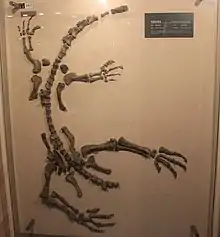

-PaleozoologicalMuseumOfChina-May23-08.jpg.webp)





